Climbing Trip Report: Red Rocks - Scouting Epinephrine
This post is a story about two climbing trips that Luke and I went on to Red Rocks just outside of Las Vegas in 2022 to prepare for an eventual climb of Epinephrine, the famous 5.9 in Red Rocks. We made progress on our climbing goals, did some scouting, changed plans numerous times, were involved in multiple accidents, one of us got a moderate injury and, of course, we had fun. Some of the accidents led to much reflection and discussion, and some of them became awesome stories of climbing at its finest. I first drafted this story in January 2023 as one of many steps I took personally to process the second trip. The story sat for a year while I finished work at Indeed and settled into post-Indeed time. In January 2024, I picked it back up with some light editing and final touches. My hope for this story is that climbers may be able to leverage some insights within and apply lessons during their climbing experiences. Non-climbers may also enjoy getting to know my world a little more even though it’s primarily a story about climbing.
Readers are warned that the story includes climbing beta, discussion of fears in everyday climbing, and a near death experience. Read on if you’d like.
And: climbing is dangerous and you assume all risk. If you use any ideas here in your own climbing, I am not responsible or liable for any injury or worse.
Gaining an objective
My climbing trips to Red Rock began in 2015 before I knew how to multipitch or trad climb and the desire to climb Epi came to me slowly over the following years. Epi is documented in Handren’s Red Rock climbing guide book which I eventually bought, probably after my third trip. In Handren, part of the Epi allure came to me through an incredible story by the wondrous first ascensionist Joanne Uroiste where she describes how the route was finally completed after much effort and harrowingly how the route got its name. In my many climbing trips to Red Rock between 2015 and 2022, Luke and I grew increasingly interested in someday being competent, fast, and strong enough to finish Epi which is known for it’s very wide and long chimney system which contains the hardest parts of the route, the sheer height of the 2240 foot route, and the 2-3 hour long hike off the summit.
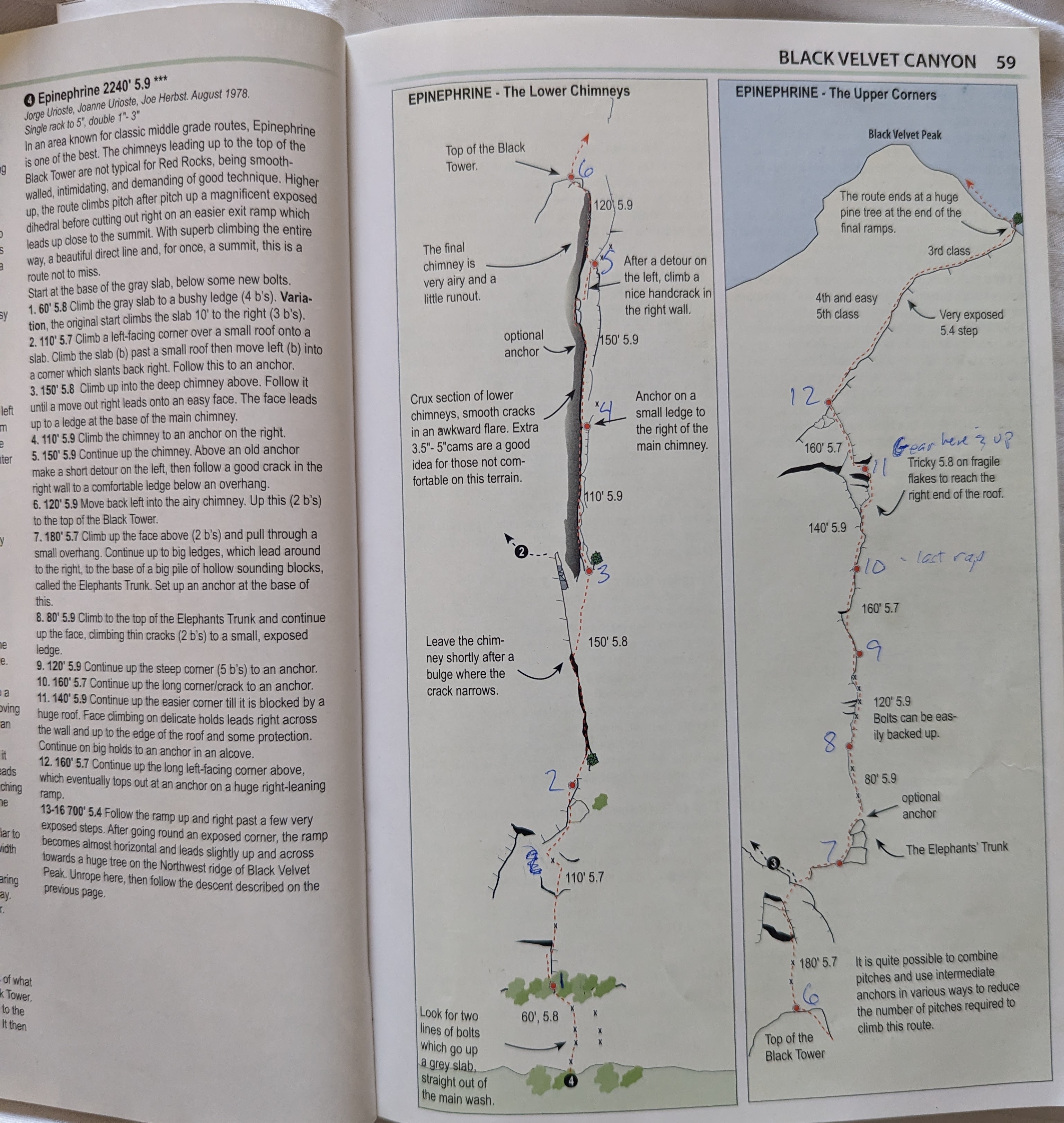 Handren’s Red Rock guidebook showing the Epi beta
Handren’s Red Rock guidebook showing the Epi beta
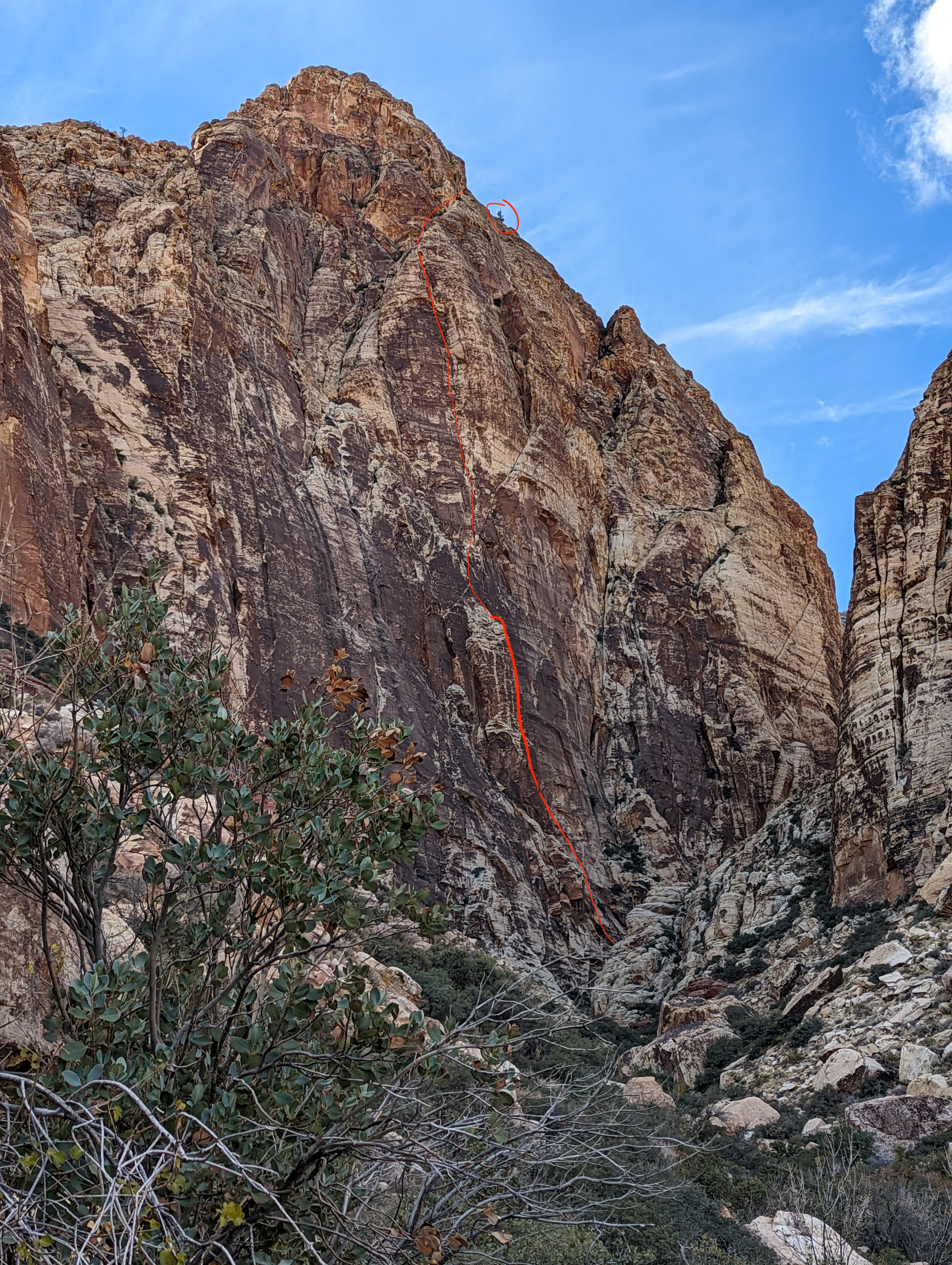 Epinephrine - follows the red line, ends at the pine tree circled at top
Epinephrine - follows the red line, ends at the pine tree circled at top
Our first Epi mission - Feb 2022
In February 2022, we went to Red Rock to gain some chimney experience on the dry sandstone and scout out the beginning pitches of Epi. We decided to do Beulah’s Book - a 3 pitch route with a 10-20 foot chimney and we completed the route! The chimney was spicy but went pretty easily for me (I followed it) and the layback above the chimney was tough for me (I’m glad Luke led it!).
The next day we went to Epi thinking we’d get up a handful of pitches to get some chimneying in. I led the first pitch and by the time I was on the wall for 5 minutes, my fingers felt like frozen hot dogs. We finished the first pitch but we were shut down on pitch 2. Luke couldn’t get out of the false chimney and onto the face, and it was very cold. So we bailed. But we learned about the hike in, the first few pitches, and that Epi is colder than other routes given its placement in the canyon.
The rest of this post is about our second trip oriented around gaining experience for our goal to complete Epi someday.
Our second Epi mission - Nov & Dec 2022
We wanted more sustained chimney practice and to try the beginning pitches of Epi again, so we planned another trip at a time which was hopefully warmer than February :) Here was our plan:
 2nd Epi trip plan
2nd Epi trip plan
- Tuesday - Community Pillar - chimney / offwidth practice
- Wednesday - Frogland - same canyon as Epi, so the drive in and initial hiking is similar, and the end of the Epi walk off is shared with Frogland too
- Thursday - Epinephrine Black Towers & rappel - the trip is oriented around this climb. Rather than climb the entire thing on this trip (as we don’t think we’re fast enough yet), we planned to climb as high as we felt like, and then rappel. This would let us learn without committing to the full ascent.
- Friday - Purblind Pillar - Just another fun climb that I haven’t done :)
Arrival day - Monday
Luke and I opted for a mid-day flight which meant that I could help Mar with the kids in the morning, and that Luke and I would arrive in Vegas with sunlight and time to get to the stores, etc.
We also realized en route that we wanted some bigger gear for Community Pillar, so had to drive 20 extra minutes to Desert Rock Sports and another 10 to REI to buy a green BigBro and blue BigBro and some cord to tie to them.
I am grateful that we chose that flight time, because with the gear purchase, hotel check-in, grocery shopping and eating, we still ended up getting to bed pretty late - later than I figured we would. But, we had the big gear :)
Community Pillar - Tuesday
Start: Worried about the discomfort of the cold weather
During: Confident, Composed, Irked at extended rappel twisting
End: Proud, Energized
I learned about Community Pillar (CP) after doing research on how to prepare for Epinephrine (Epi) on Mountain Project (MP) Youtube, and other online sites. We planned to climb CP as a warm up for Epinephrine because they both have chimneys. CP is technically easier and shorter, so it’s less demanding and less committing. We also did a chimney route in February 2022 - Beulah’s Book - but the chimney section is brief compared to CP and Epi. So, CP was a nice step towards skill development for Epi.
On our drive in, we started to get worried that CP would be too cold. It’s a north facing route, so there’s little to no sun. We stopped along the Scenic Loop, well before the approach to CP, to determine if we wanted to pivot to a different climb. We consulted the book, and decided on something that was in the same canyon as CP. When we got to the parking lot, I chatted with the first climbing party I saw - I asked them what they were getting on, and they returned the volley. I said “Community Pillar” and they replied “Ohhh that’s going to be cold, good luck!” At this point, Luke and I heeded their warning and considered doing another route. However, the second climbing party said they climbed CP days before - in slightly colder weather - and it was fine. So, we said, alright let’s stick to the CP plan. If we were too cold, we could always bail by leaving gear anchors behind since there are no bolted anchors to rappel from on CP - this is a risk that we face with some trad routes; a risk I’ve never needed to compensate for (yet).
We decided that I’d lead the hard pitches. And, the first crux - though not technically very difficult - is a very tight squeeze chimney on the first pitch. It’s so tight for some climbers - stories on MP describe how leaders had to take their harness off, their wallet out of their pocket, etc. We snagged some really useful beta around orientation of which hip goes in first and where to put your minimal gear (from Bill Lawry on Mountain Project from Oct 2016).
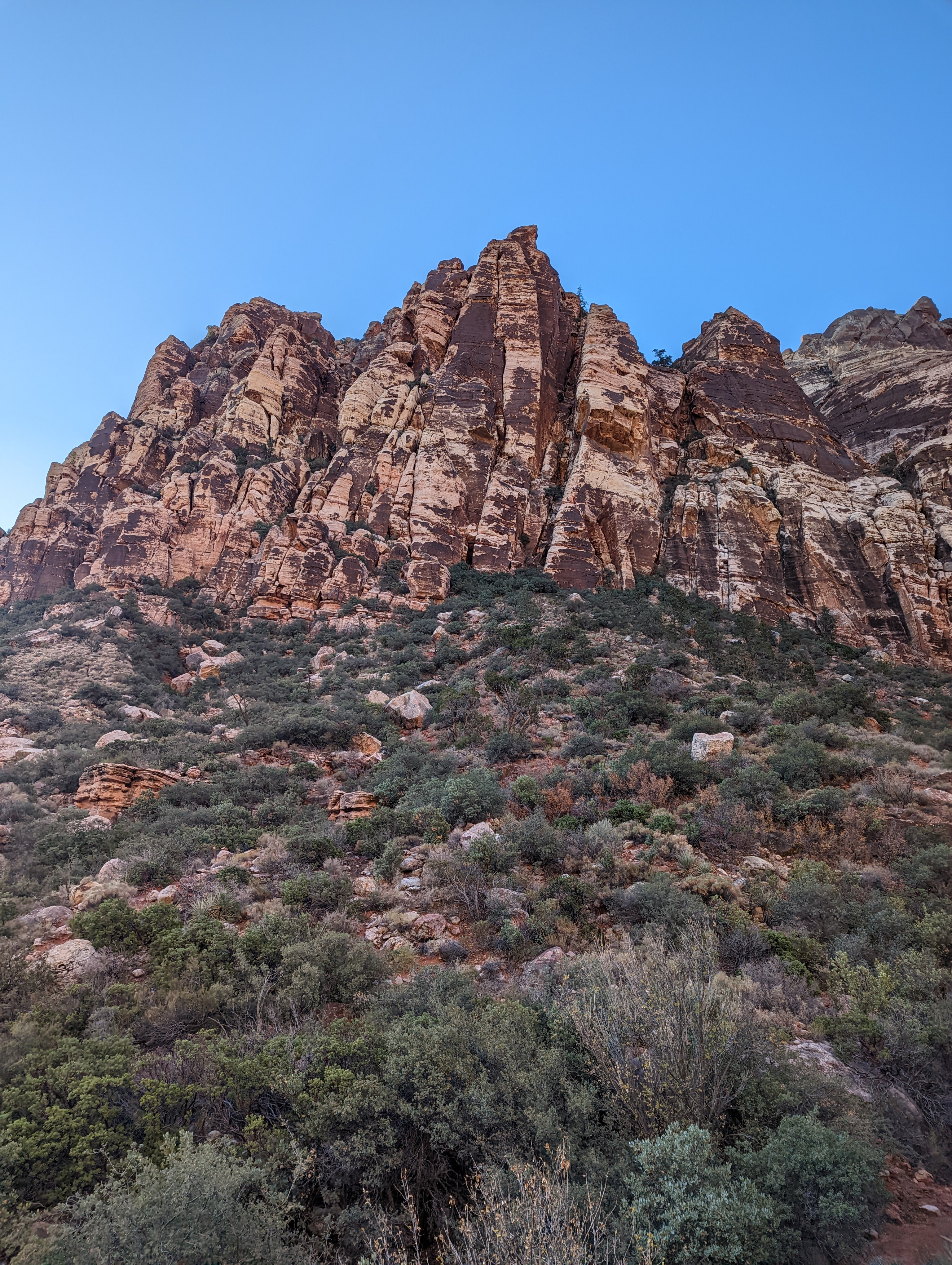 Community Pillar on the North Face of Magic Mountain in Red Rock Nevada
Community Pillar on the North Face of Magic Mountain in Red Rock Nevada
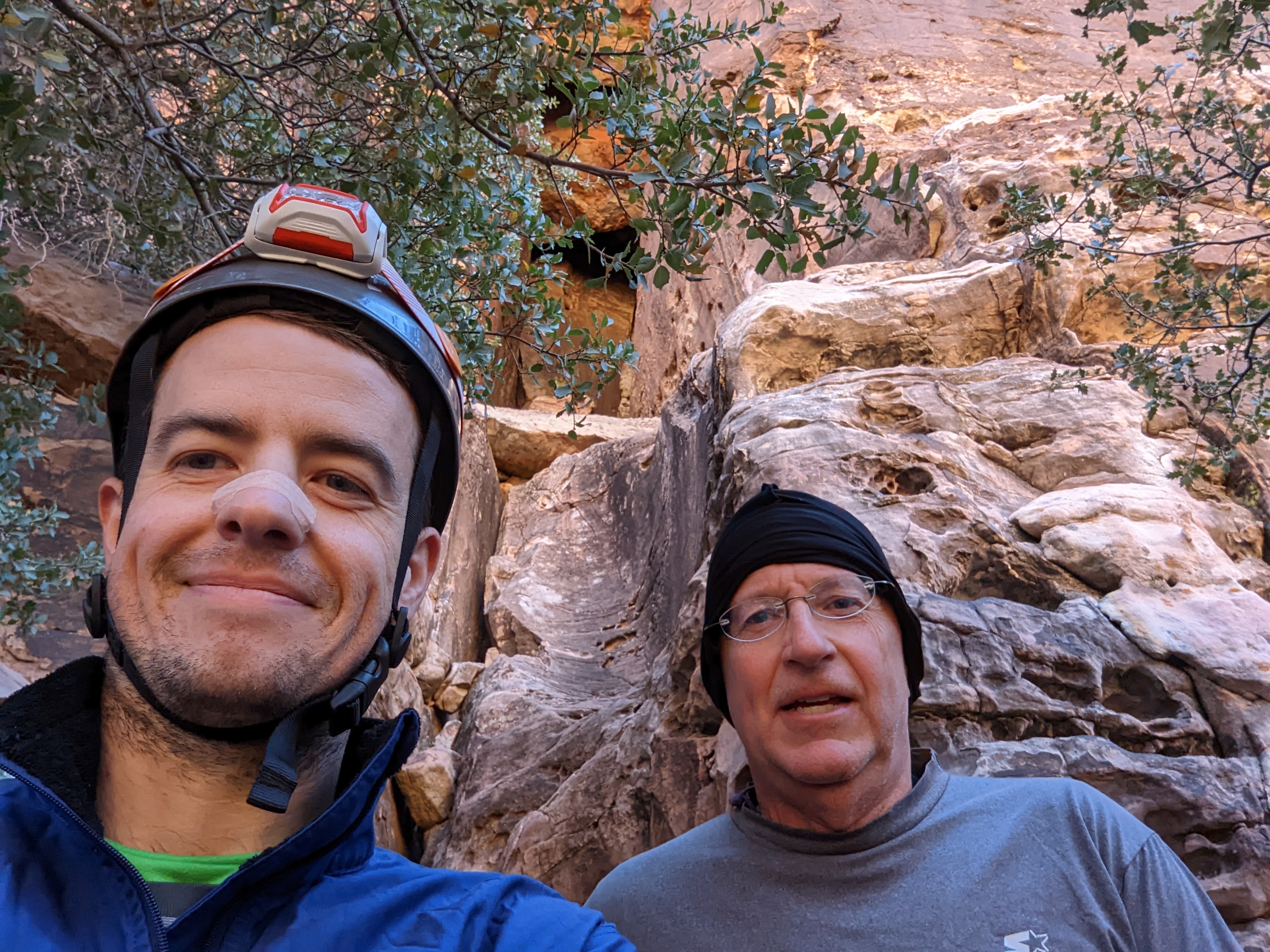 Luke and I at the start of Community Pillar
Luke and I at the start of Community Pillar
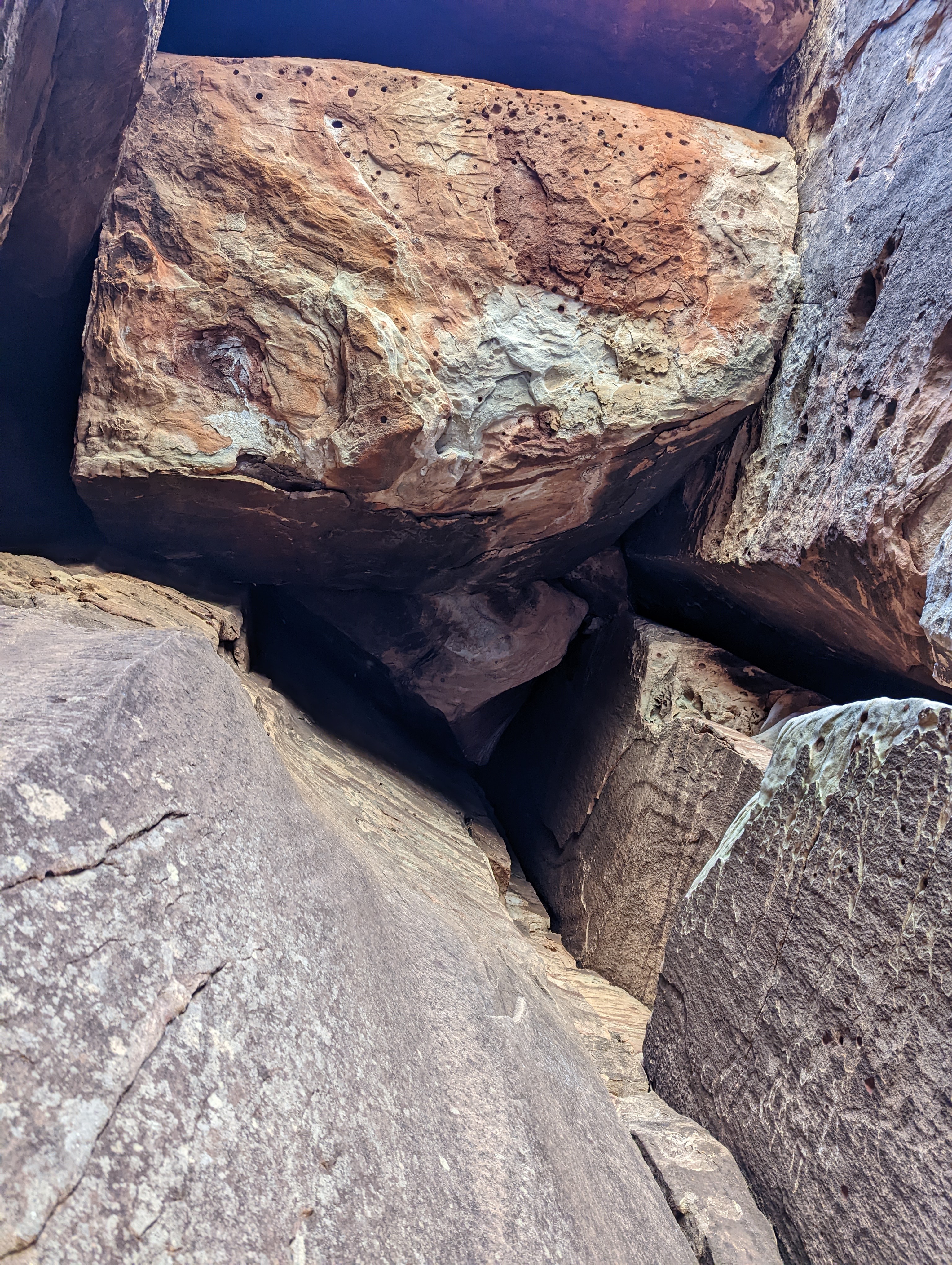 Chockstone with a squeeze chimney at the start of Community Pillar
Chockstone with a squeeze chimney at the start of Community Pillar
That beta worked for me, and I easily got through the squeeze chimney in a minute. After anchoring, I proceeded to drop a loop of rope down to Luke. Luke attached our packs & gear to the rope, I pulled it through the chimney, then belayed Luke up through the chimney. After probably 10 minutes of reorganizing everything, Luke set off on the next pitch.
Our next pitch was offwidth, and it seemed strenuous for Luke. At times, he had both sides of his hips into the offwidth, kind of using his hips as a chockstone. I wanted to try a different technique; so, as I later followed, I tried a left hip in. I think this was a little smoother than Luke’s struggle - but Luke’s also slightly taller and heavier and had a larger backpack that sat lower on his back - mine was a teeny tiny marathoner’s pack that was high up on my upper back and shoulders. As I got to the top of the pitch, we reviewed the route and that maybe I should have led that offwidth so that I could do the harder pitches (p1 and p3). Oops - this sometimes happens in trad :) especially when there are no bolted anchors and you are making anchors from your own gear.
Luke ended up leading pitch 2 so that I could lead p3. I don’t really remember much of p2.
I remember p3 though! This was the pitch that everyone on MP was saying was run out. This is the pitch we bought big gear for. And yes, I used the big gear and I’m glad I had it.
Pitch 3 - injury and water
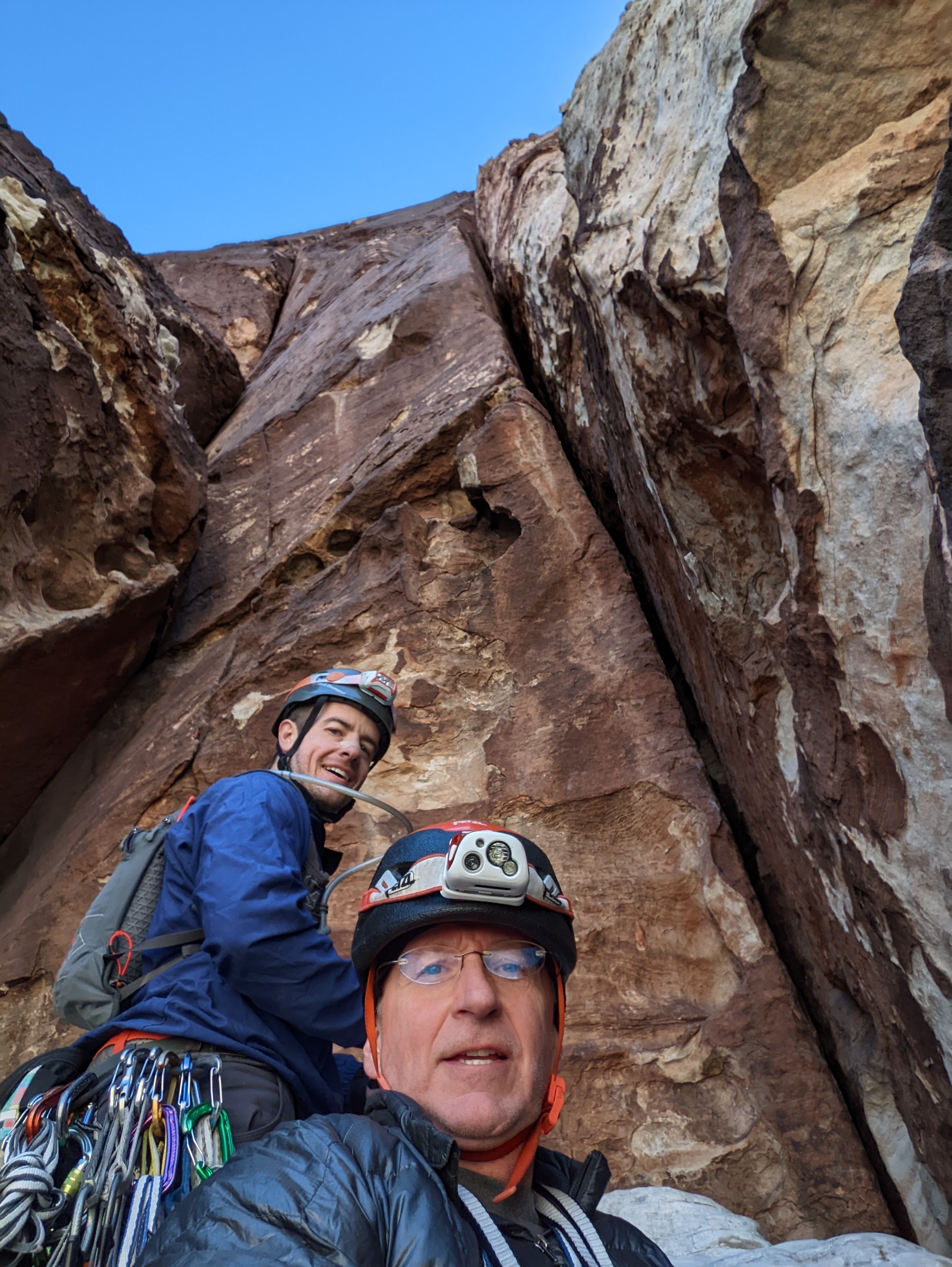 Start of Community Pillar pitch 3
Start of Community Pillar pitch 3
Starting p3, I got a piece of gear in at about 10 feet up, and then was about 20 feet above Luke at a nice resting point to place my second piece. The offwidth was quite wide here, so I went for a BigBro. It was my first time placing a BigBro - my training consisted of practicing pressing the button trigger in the hotel room a few times. I felt a little awkward placing it, whereas with cams and nuts I feel cool and smooth. Something went wrong.
I can’t remember if Luke mentioned it to me first, or if I noticed it first; but, my hand was bleeding. Closer inspection revealed that my left pinky had been gashed open and was losing blood quickly - enough to drip down 20 feet to the ledge Luke was on. I hadn’t yet gotten the BigBro in, so I secured that to my harness. I downclimbed to my first piece, Luke took in the slack and held me tight so I could address the situation. Fortunately, in my backpack’s arm strap pocket, I had tape. So, I was able to get the tape out easily and improvise a bandage for my pinky. The pinky had minor pain when I pressed on it, but the bandage seemed to stall the profuse bleeding. I would be able to continue climbing.
I got back up to the point where I wanted to place the BigBro and placed it. And kept going. Higher up the offwidth opened even more, and I was able to get left hip in, with my back against the wall. I was feeling very secure since I was wedged in the chimney. And something else went wrong.
Water started gushing from my backpack. What happened? The mouthpiece on my water bladder hose disappeared. It must have popped off in my chimneying. How frustrating! At first, I tried to hold it in my mouth. But as I moved up and pressed on my backpack, water gushed out and I couldn’t contain it all in my mouth. So, I did a double knee-bar to stay in the chimney and have both hands free. Kinking the water hose stopped the flow, like I’ve done a million times with the hose in the backyard. So, I snagged my trusty tape from the backpack arm strap pocket, and tapped the hose in a kinked shape. That stopped the water from leaking. Phew!
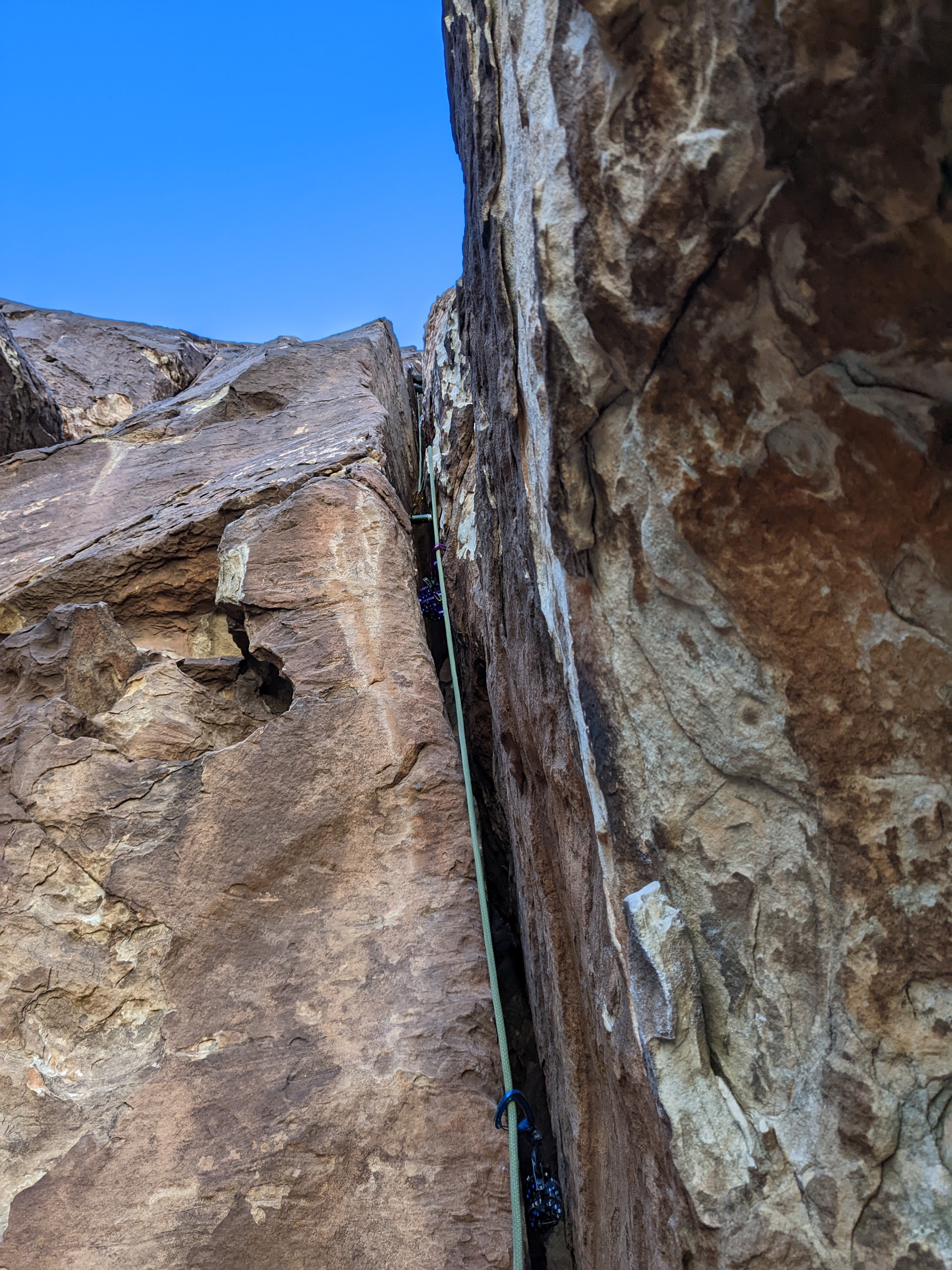 Community Pillar pitch 3, you can see the big gear - a blue 3, a purple 5, a
green BigBro
Community Pillar pitch 3, you can see the big gear - a blue 3, a purple 5, a
green BigBro
I was able to complete the pitch without needing to get my tape out anymore haha. The remainder of the pitch had some runout sections, and I’m glad I had some smaller gear towards the last half.
The end of the pitch was pretty neat - I got to pass a huge bird’s nest while plunging into a deep dark cave, and then come out through a keyhole back to light.
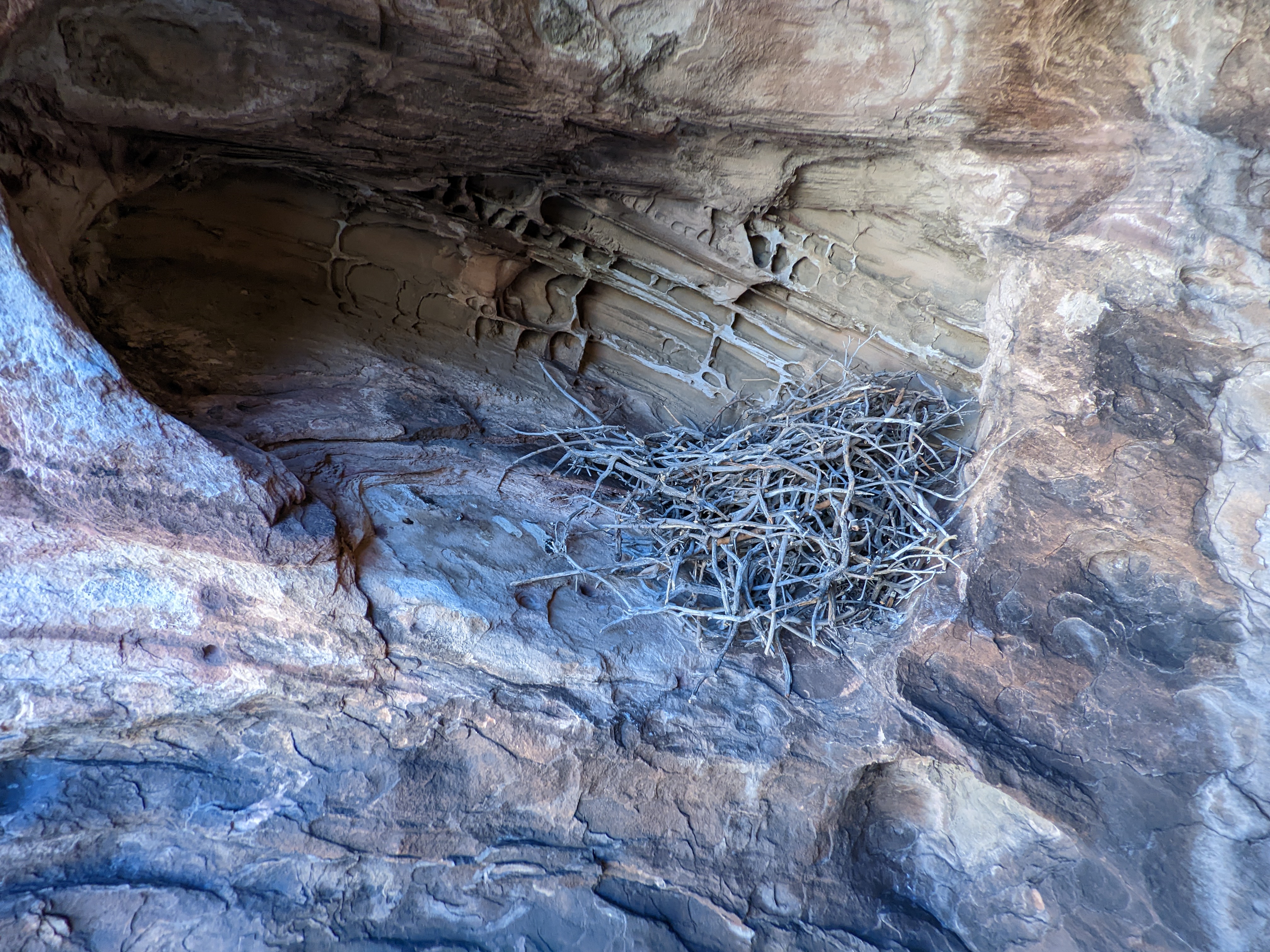 Community Pillar pitch 3 bird’s nest
Community Pillar pitch 3 bird’s nest
At this point, I had done a u-turn through the keyhole and was facing the canyon, and my options were to build an anchor in the tight keyhole, or navigate around a bulge facing the canyon to do another u-turn. Scared, I set up my anchor in the tight keyhole - it was awkward, but felt very secure.
After super awkwardly belaying Luke up to me, I realized that I didn’t need to have been nervous about continuing around the bulge on lead for the second u-turn because the rope would have been doing a big S after the double u-turn and the rope around the rock would have acted like natural protection had I fallen. So, when Luke arrived, I asked him to build an anchor 5 feet to my side so that our next pitch would have less rope drag. Awkward, but such is life sometimes. Live and learn, right?
Luke led pitch 4 and anchored at the base of the huge cave per the Handren guidebook.
Pitch 5 - a most favorite pitch ever
Pitch 5 is one of my most favorite pitches ever. We start in this huge cave with two main options: an offwidth on the left side of the cave, or a juggy layback crack in the back right.
Note: We have a video from here, once I figure out how to get it in the blog, I’ll add it.
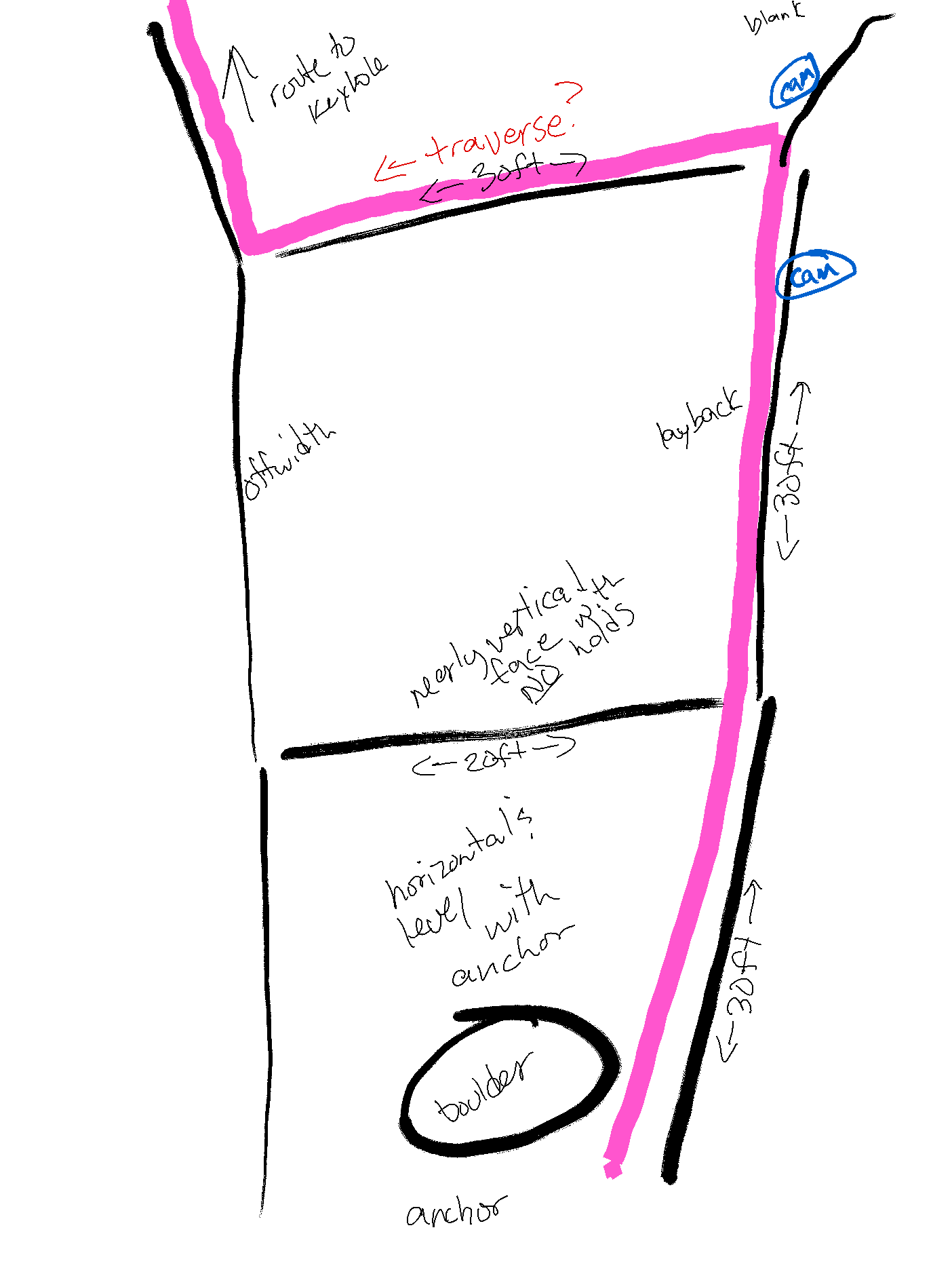 Start of Community Pillar pitch 5 drawing
Start of Community Pillar pitch 5 drawing
These two options are probably 20 feet apart, but the right option goes up and right, so at about 30-40 feet above, they’re more like 30 or 35 feet apart. The back of the cave on the right seemed easier even though I suspected that I’d need to traverse back to the left to the top of the offwidth to finish the pitch. I got one piece in at about 20 feet up, and then reached the ledge 30 feet up - yes, I’d need to traverse left. Fortunately there was a beautiful 3-4 inch ledge to walk across, and the top of the cave on the left that I could reach to. I placed a cam before traversing since, unlikely as a fall was from this 3-4 inch ledge, if I’d fall without protection this high, I would surely fall 30-40 feet to the deck. Not that I wanted to fall after this piece anyways, since a fall with the piece at the ledge would mean a pendulum from the back into the side of the cave. Either option would have resulted in an injury.
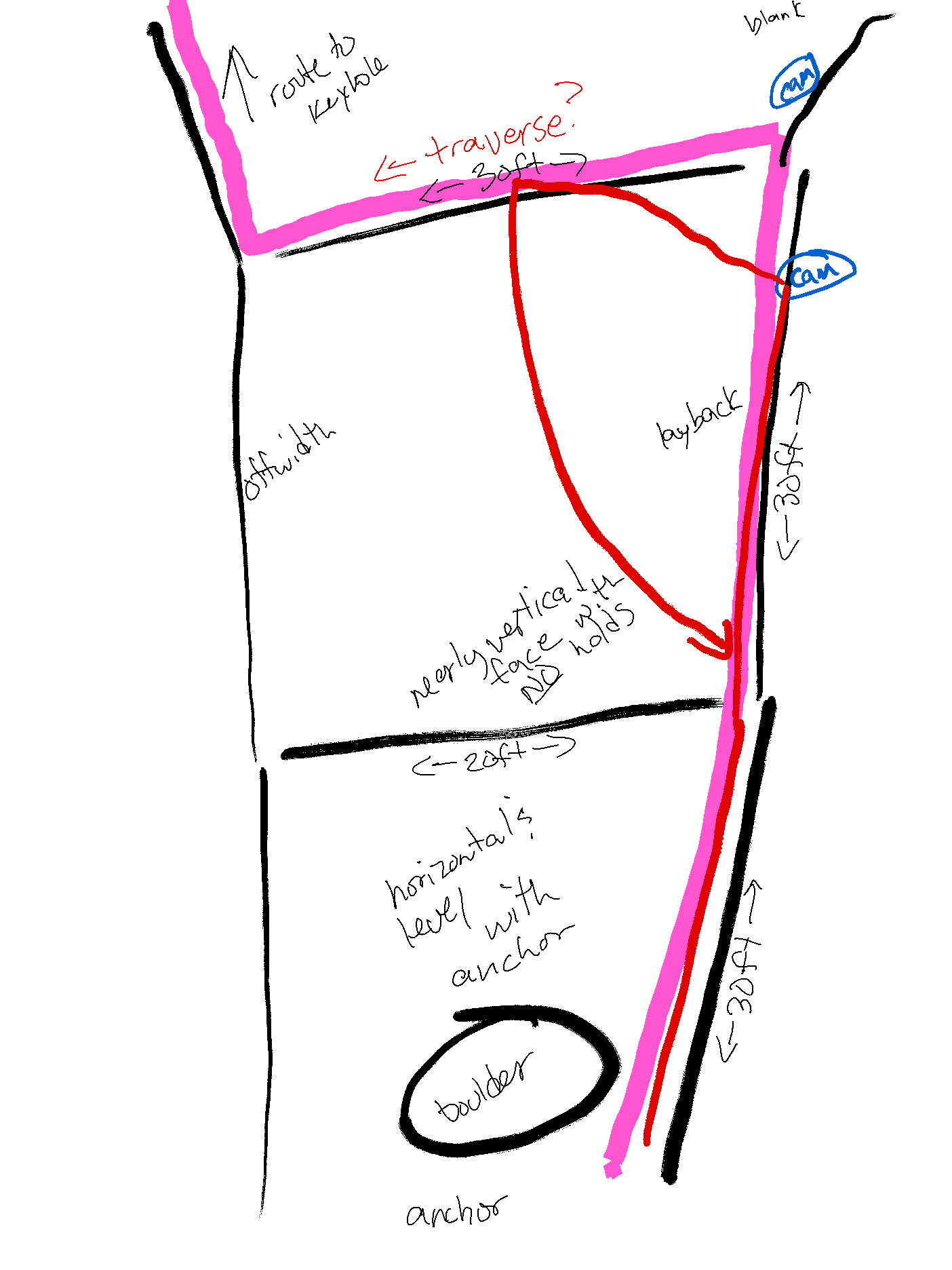 Start of Community Pillar pitch 5 fall risk 1
Start of Community Pillar pitch 5 fall risk 1
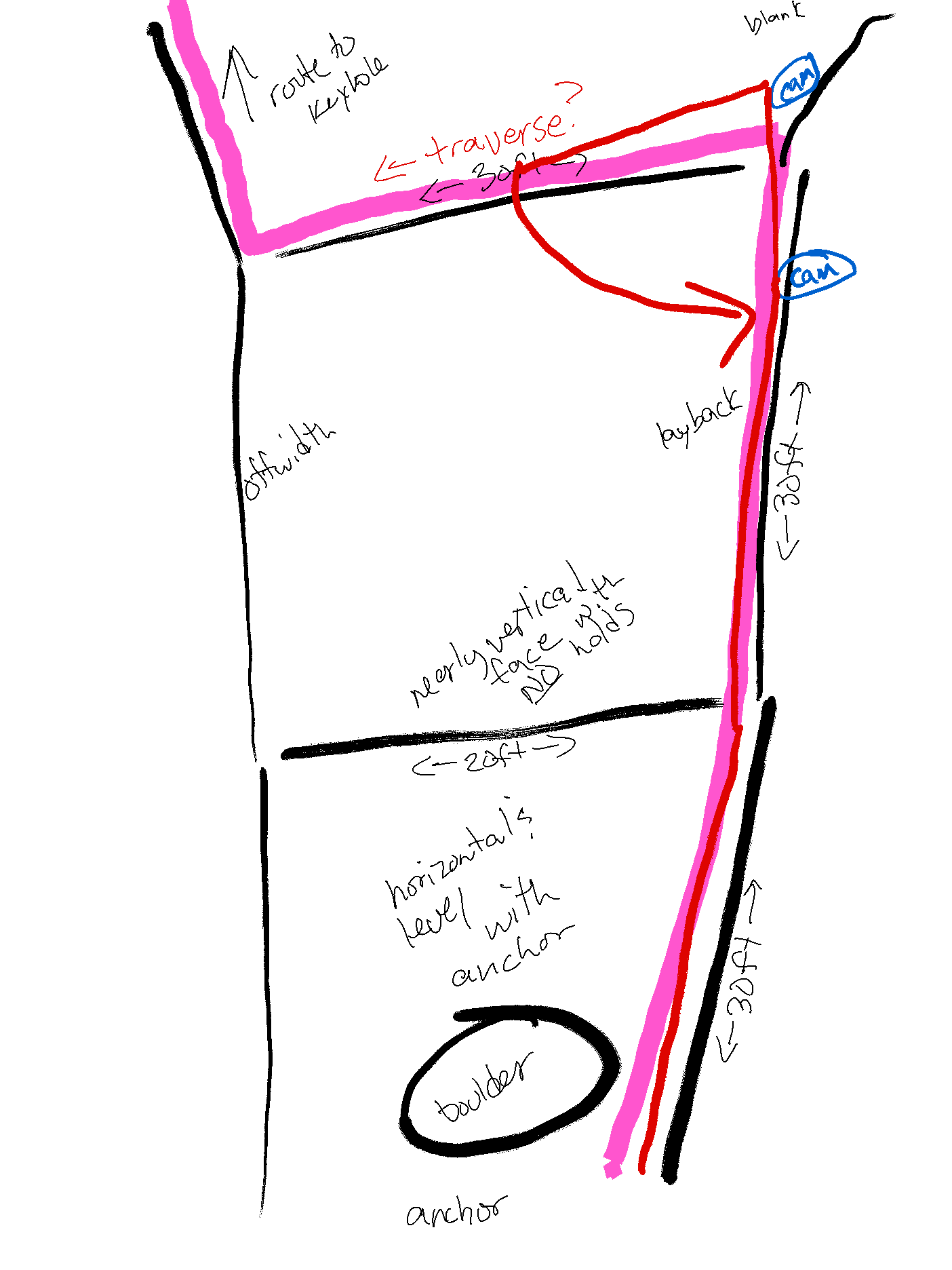 Start of Community Pillar pitch 5 fall risk 2
Start of Community Pillar pitch 5 fall risk 2
But, I wasn’t nervous because the ledge and cave made the traverse seem secure. It was fun! When I got to the left side, I got a piece in the crack that continued after the left offwidth. Looking around on how to continue, the crack with the piece was an option but I kept looking around and realized that the top of the cave that was on my left during the traverse opened up with some huge huecos.
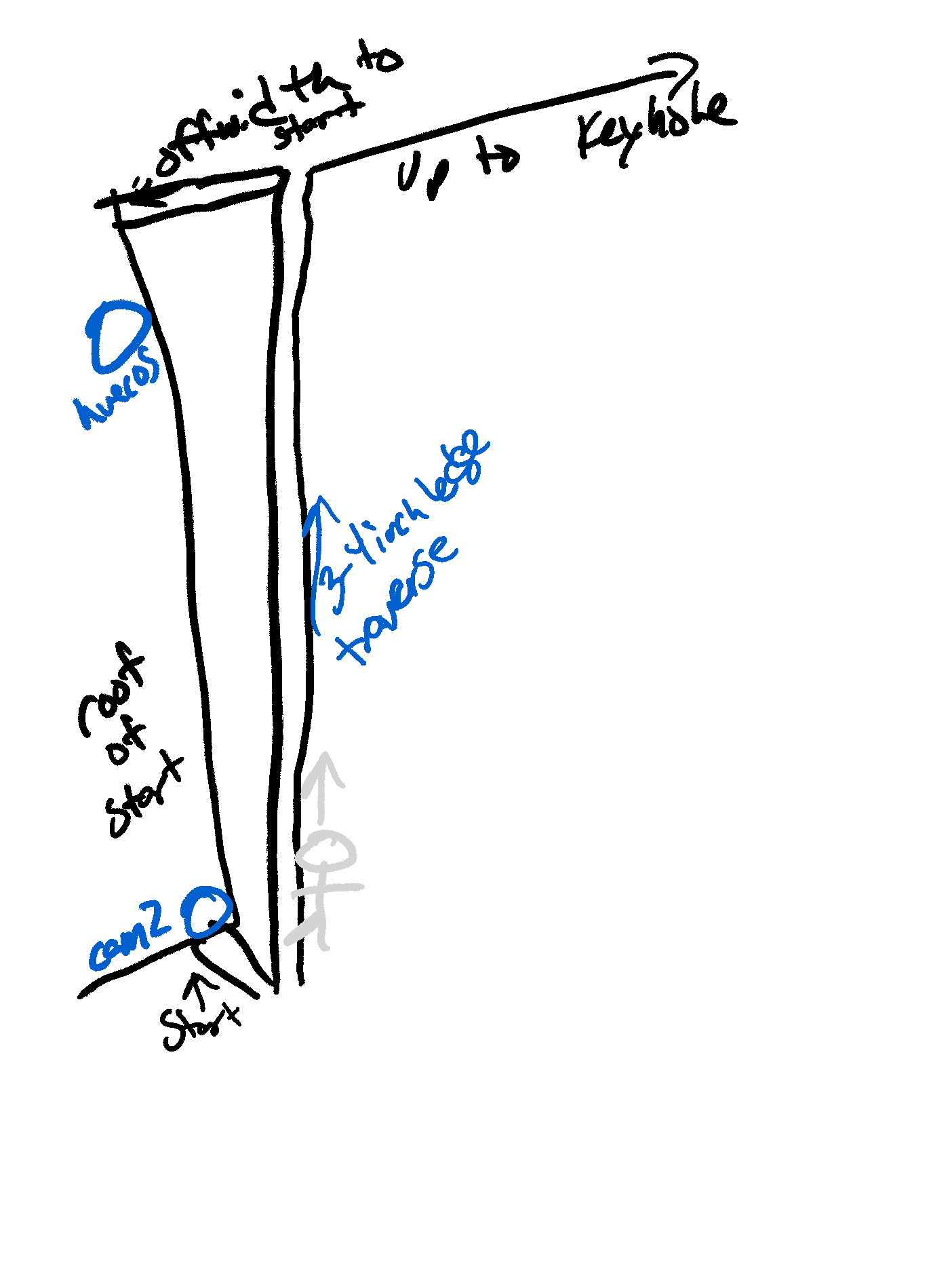 Community Pillar pitch 5 traverse drawing
Community Pillar pitch 5 traverse drawing
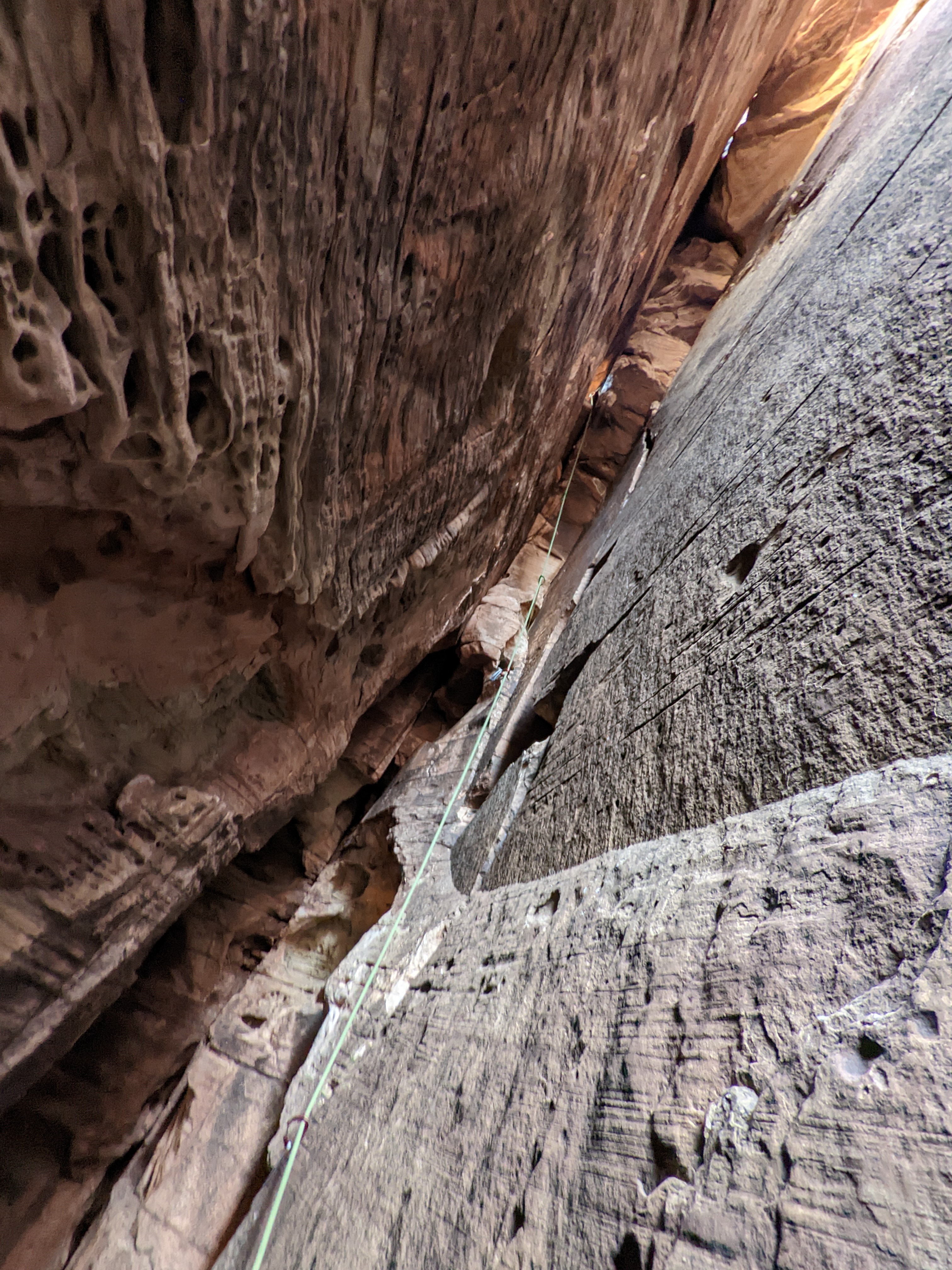 Community Pillar pitch 5 traverse photo with the walls on the left/right and
the rest of the route in front/upright exiting the tiny keyhole. This was taken
by Luke following my lead, so you can see the green rope.
Community Pillar pitch 5 traverse photo with the walls on the left/right and
the rest of the route in front/upright exiting the tiny keyhole. This was taken
by Luke following my lead, so you can see the green rope.
Cool! It seemed like a gym route with fun stemming across a chasm and using a hold behind me - a truly multi-dimensional section of the climb.
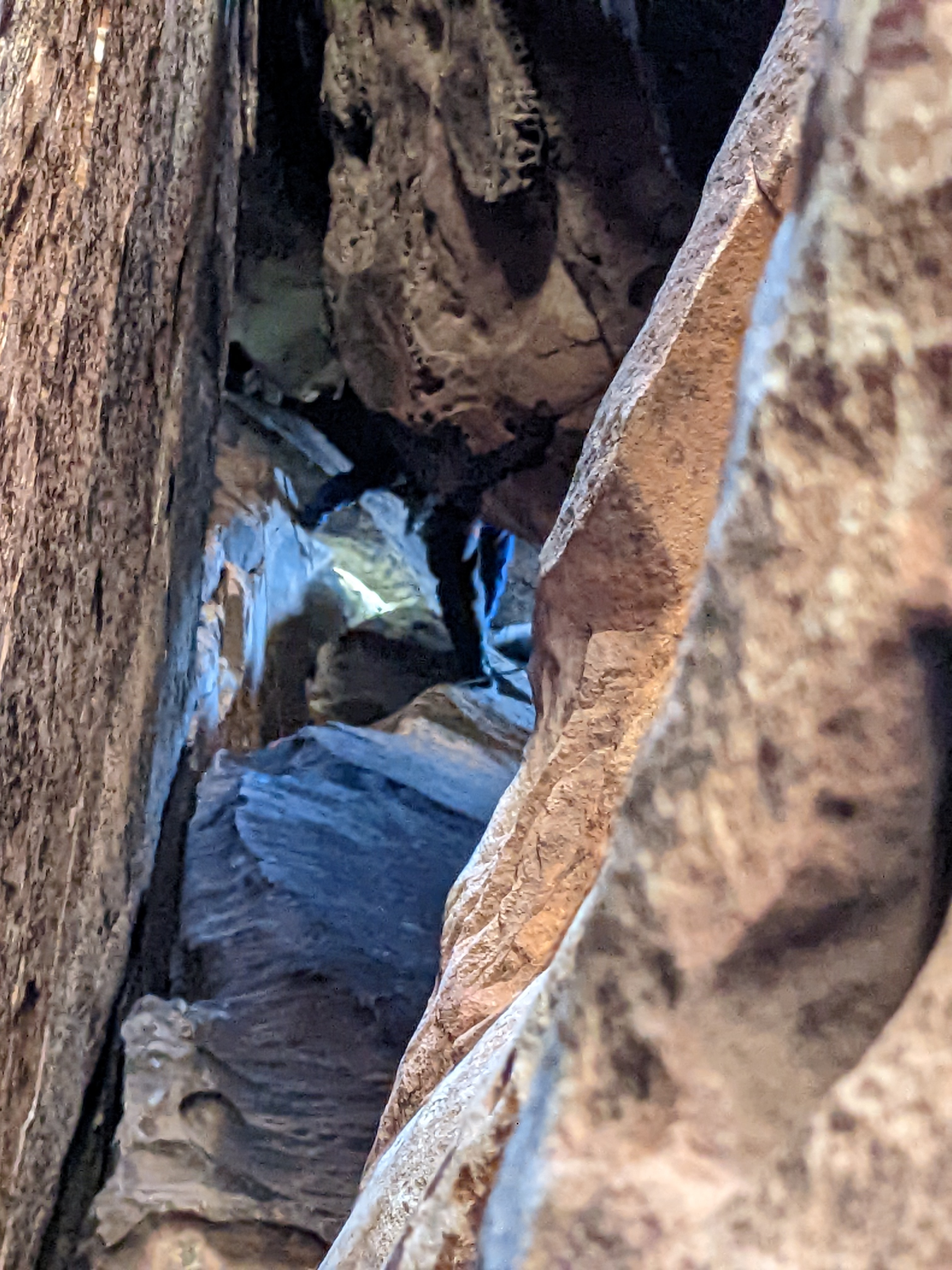 _Community Pillar pitch 5, me climbing the fun stemming section. Luke took this
picture from the start of pitch 5.
_Community Pillar pitch 5, me climbing the fun stemming section. Luke took this
picture from the start of pitch 5.
I continued up to the keyhole, crammed myself in, found a giant cave that was very secure, set an anchor, and started to pull the rope up for Luke to follow. But, the rope had a lot of drag, so I put a cam at the top of the keyhole so the rope would be straighter and not dragging over a tight corner, and then the rope was much easier to pull. Luke joined me and we oozed to each other at how fun the pitch was :) I think I’d do this entire route again just to do that pitch again!
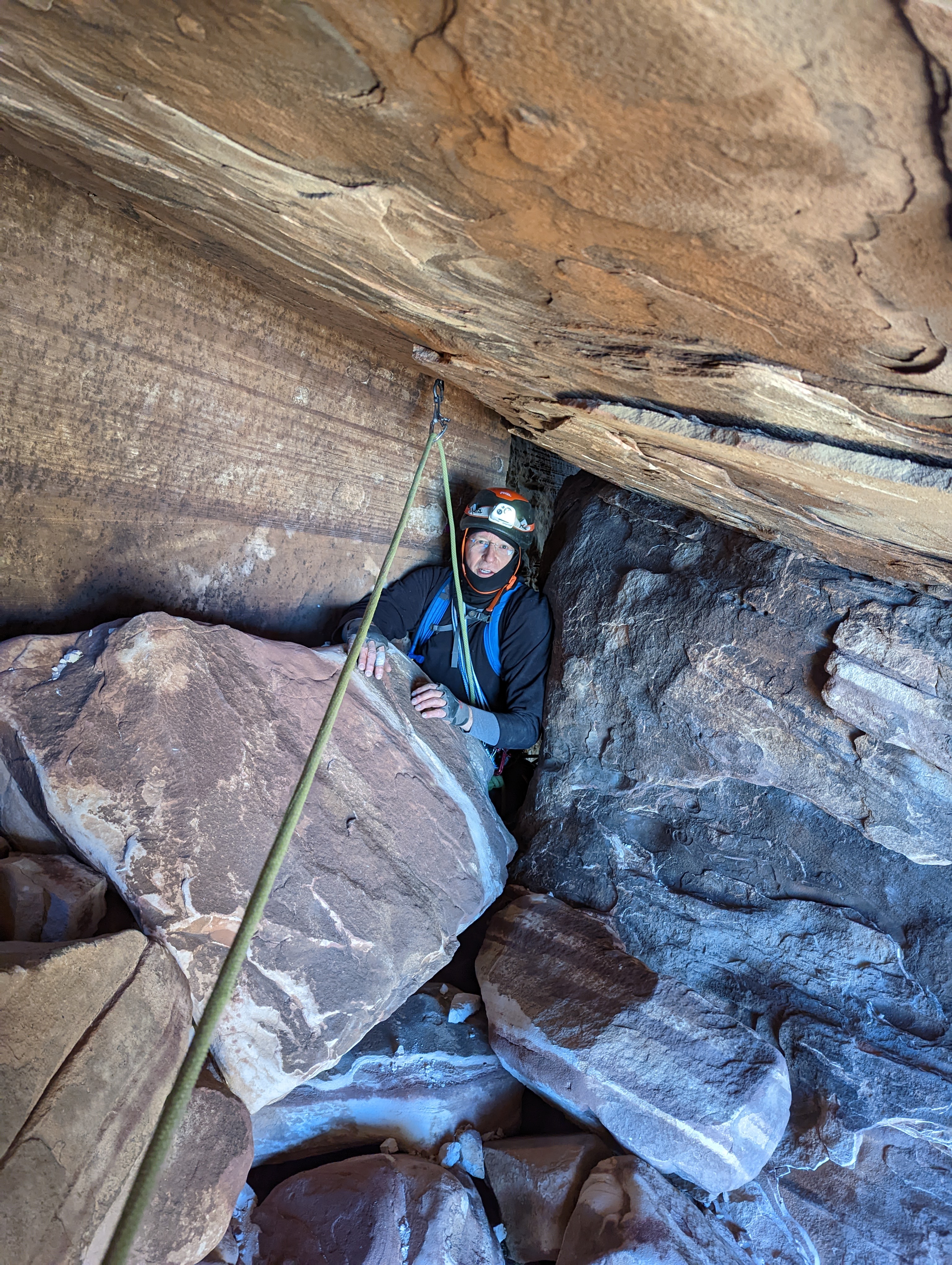 Luke climbing through the keyhole at the top of Community Pillar pitch 5
Luke climbing through the keyhole at the top of Community Pillar pitch 5
The rest of the climb, per the guidebook, was easier. Luke led us out of the cave to an anchor point. I led the final push to our high point from where I could see what I thought was the descent tree described on Mountain Project.
To get to that tree, we’d need to cross a chasm. Had I crossed the chasm on my lead, Luke and I might not have been able to hear each other talk. So, Luke joined me at the high point and I belayed him to lead us across a chasm.
This felt a little dicey to me: as Luke was exploring how to cross the chasm, some of the rock crumbled under his steps. Typically when this happens in trad climbing, it means the exact path is not taken by the others who climb this route. As a section of a route is climbed repeatedly, the crumbly bits are all knocked off, and we’re left with more stable rock. So, that it crumbled on our climb means we’re probably off route. I followed him, and didn’t notice a cam until after I crossed the chasm. Damn. So I had to go back over the chasm to get the cam, and then re-re-cross the chasm.
During these shenanigans, I also felt the rock crumbling and therefore got more cautious. Luke was trying to talk to me, and I cut him off saying to be quiet right now while I finished the move. (Later in the week, Luke recalled this moment and another like it and asked me if I was mad at him. I clarified that no, I wasn’t mad at Luke, but I was drawing my safety boundary with a little healthy anger to be firm and quick. When I wanted to focus, I had let him know that talking was too much for me at that time.)
From here, Luke belayed me while I scrambled to the tree to see if that was our descent tree, and if we needed to be roped anymore. It was our tree, and the path was flat and secure, so we didn’t need to belay Luke to me. We got to the tree with ease and comfort, and started our multi-pitch rappel.
The first rappel required care because there were many loose rocks at the rappel station. So, I rapped slowly and made it to the huge ledge, walked on flat ground for a while and found the next rappel station. Because the ledge was about half the size of a basketball court and the path to the next anchor only required a little bit of scrambling, I wouldn’t need to anchor myself before coming off belay. I took shelter before Luke rappelled in case loose rocks came with him, but none did. We continued on the next rappel, again able to walk to the next rappel station without needing to anchor ourselves until we got to the next station.
The next station was hanging, so we both anchored in to set the rappel system up. In these scenarios, you’re literally walking from a flat terrace to the cliff’s edge, so there’s instinctually heightened awareness - you slow down, become deliberate, and anchor yourself in. These are clearly moments in trad climbing to be cautious.
And, they’re also relatively common. So, it’s not a scary thing (anymore anyways).
I felt such a thrill on this rappel because I got to go through a tunnel into a hanging rappel where I was in free air!
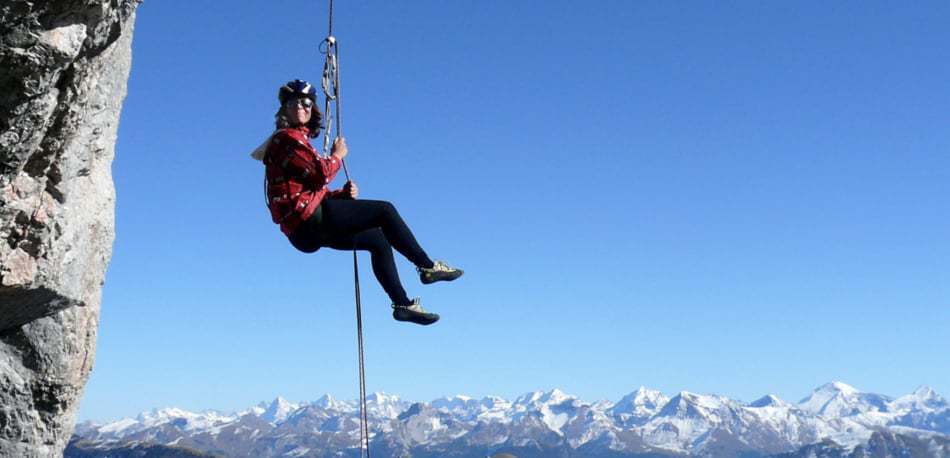 Free hanging rappel from https://ascentionism.com/7-different-types-of-rappelling-everything-you-need-to-know/
Free hanging rappel from https://ascentionism.com/7-different-types-of-rappelling-everything-you-need-to-know/
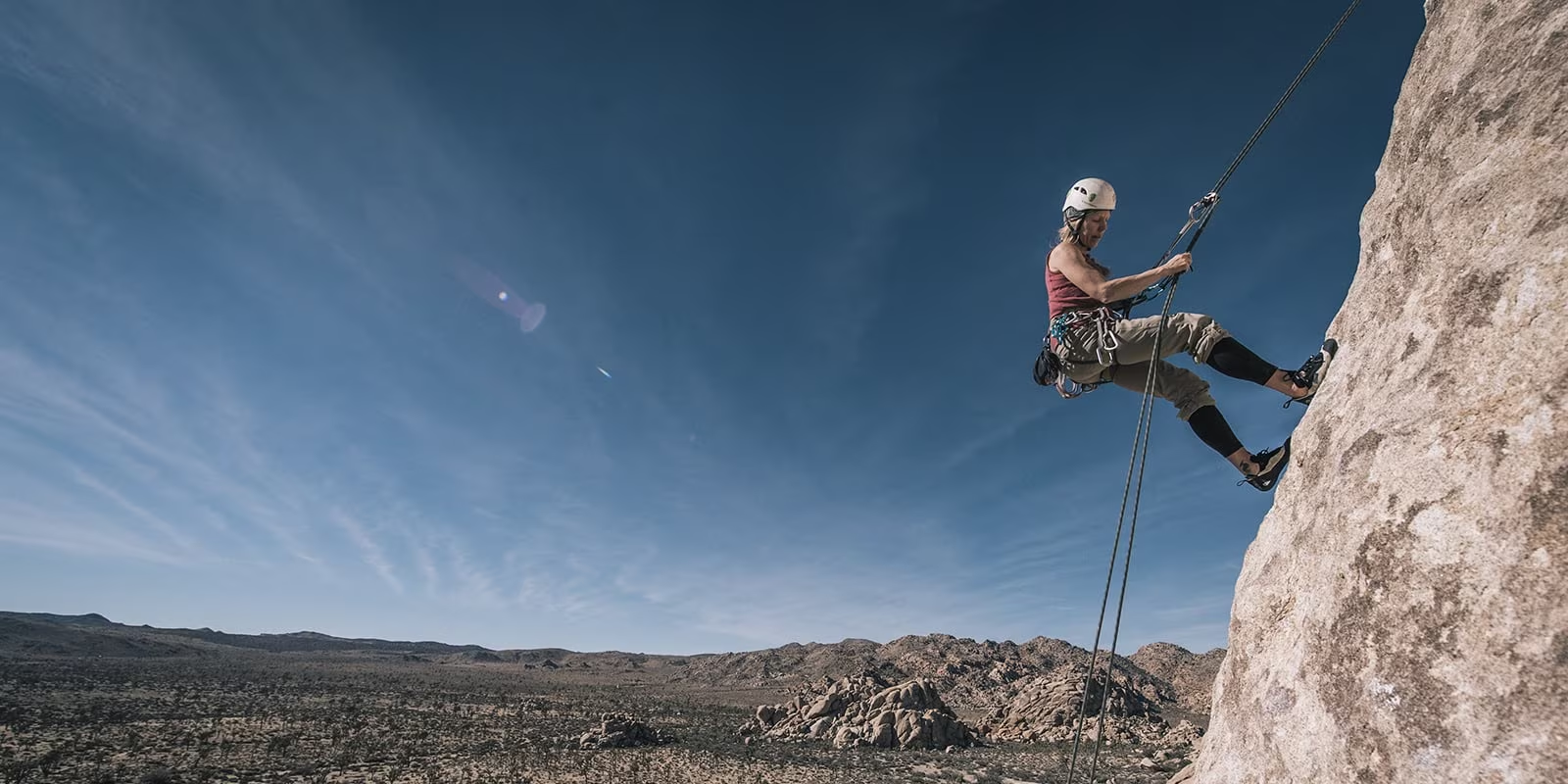 Standard rappel with feet on the wall from
https://www.rei.com/learn/expert-advice/how-to-rappel.html
Standard rappel with feet on the wall from
https://www.rei.com/learn/expert-advice/how-to-rappel.html
However I also felt super annoyed on this rappel because my rappel extension was getting tangled upon itself with the rappel device flipping upside down and the dyneema sling that was my extension was wrapping around the ropes, causing extra friction and made me a little nervous that the rappel system would fail. I realized mid-rappel in mid-air that I could unstick it by pulling out on the extension. This helped. And, I also decided to skip the extension next time. I needed a different way to anchor myself for the remaining rappels today because my rappel extension was doubling as my personal anchor.
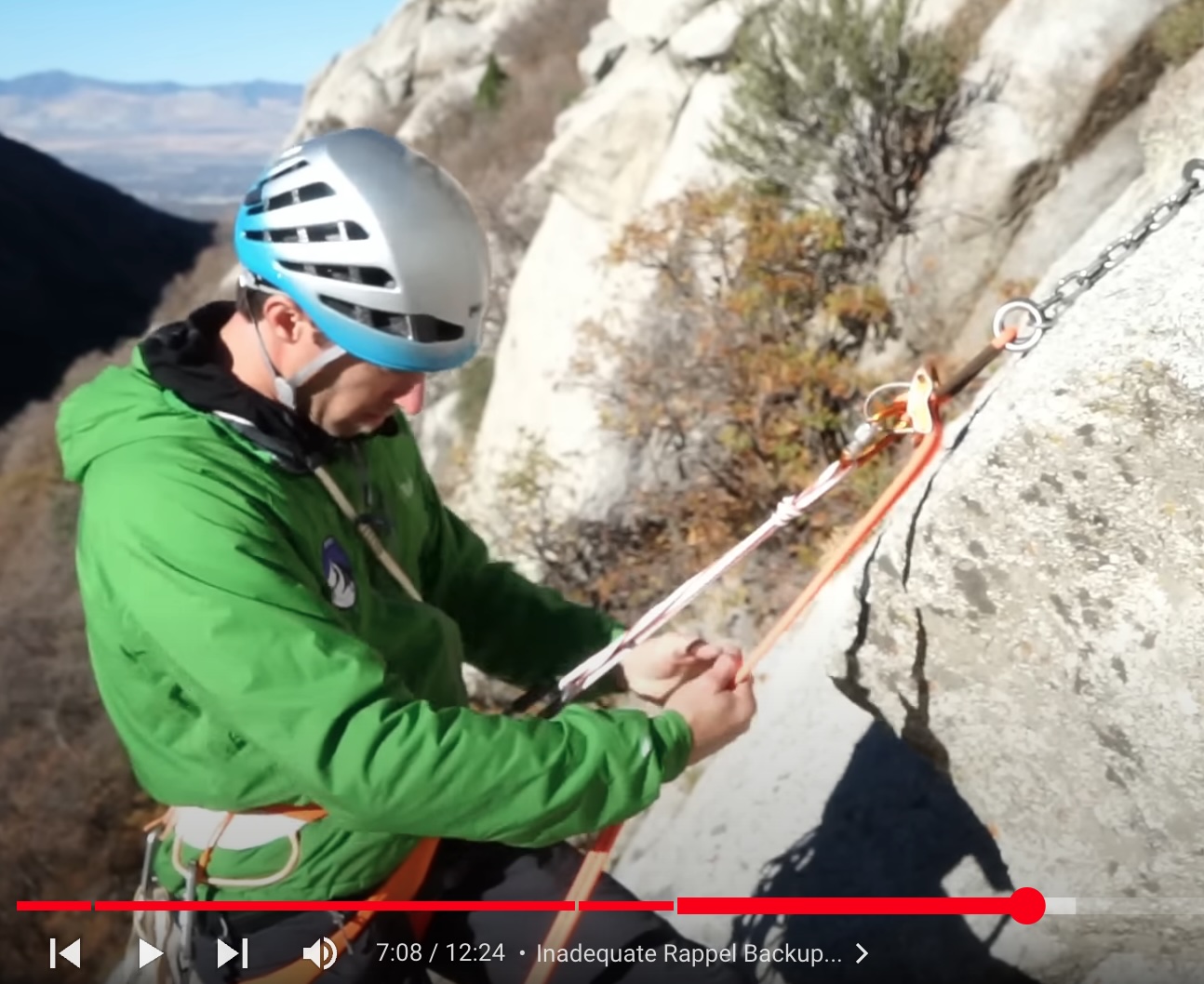 Rappel Extension from
https://youtu.be/0qgygg8pzGI?list=PLUdI1Hdrq6EE5VRd8WHIDDTCEZGdcK-vH&t=428
Rappel Extension from
https://youtu.be/0qgygg8pzGI?list=PLUdI1Hdrq6EE5VRd8WHIDDTCEZGdcK-vH&t=428
I’ve recently started trying this type of rappel extension / personal anchor setup since it means I don’t need a piece of gear which has a single typical use. In previous years, I’d used a parcel-prusik adjustable personal anchor.
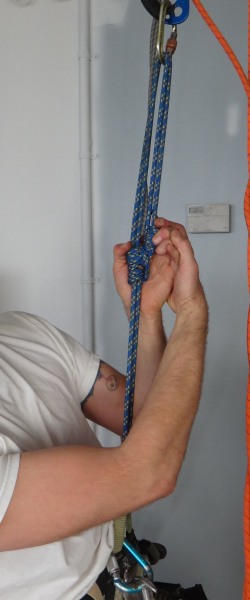 Purcell Prusik Rappel Extension rom
https://www.bluugnome.com/shareables/purcell-prusik/purcell-prusik-tether.aspx
Purcell Prusik Rappel Extension rom
https://www.bluugnome.com/shareables/purcell-prusik/purcell-prusik-tether.aspx
This personal anchor is nice because it’s adjustable and super safe because it’s a nylon rope which can absorb falls better then dyneema. However, I’d typically carry this anchor all day only to use it on rappels.
Anyways, for the rest of the CP descent, I opted for the simplest choice of girth hitching a dyneema sling to my harness hard points and clipping this to a bolt. I backed it up with a second dyneema sling which was clipped from my belay loop to the other bolt. The downside to this approach compared to my earlier approach on CP is that it’s less comfortable because the sling is longer and I’m further away from the anchor. But it’d do for the final 1-2 rappels.
We made it to the ground safely and also knew that we were farther right than we started the day. So, we located the exit path by traversing the base of the mountain back to the start of CP from where we could take the well worn trail back to the parking lot.
We had deep dish pizza for dinner 🙂
Rest - Wednesday
We decided to take a rest day on Wednesday, rather than stick to the schedule to climb Frogland. I’m glad we rested, my body definitely benefited from rest after travel/arrival day and the long Community Pillar day. We had a nice breakfast at a diner, enjoyed coffee and chats about addiction, authenticity, attachment, trauma and more for a few hours at a coffee shop, saw The Fabelmans at the theater and had a tasty hot chicken for dinner.
Epinephrine
Start: Confident, Excited, Awed, Afraid
End: Relieved, Proud, Fatigued, Perplexed, Melancholy, Insecure, Uneasy
This was the second time that we climbed the beginning of Epinephrine (Epi). In both ascents, we knew we would rappel at or before the top of the Black Towers; we knew we couldn’t make it to the summit given our current climbing skills, confidence and therefore speed. But, we’re enticed by the stories of Epi, and in awe of the challenge. Trying it would allow us to push ourselves and to savor the sweetness and bitterness of progress.
“The more you know, the more you realize you don’t know.” -Aristotle
We had a full rest day before Epi, so we were as physically recovered as we could be. Though, surprisingly, we still stayed up later the night before Epi even though it was a rest day. Pre-challenge nervous butterflies?
We decided to arrive at Epi at 7am, later than first light, because we knew we were rappelling, wanted to give other parties, who were doing the whole 13+ pitch route, the first ascents of the day, and also wanted more light for the hike in. It was meant to be a casual challenge day, not a Type 2 fun epic challenge day. We figured about 1 hour to wake up, eat, and prepare food for the day. Our hotel was 45-60 minutes from the Black Velvet Canyon parking lot (with the “hike” from our room to the hotel parking lot). We knew the hike from the Canyon parking lot to Epi would be about 1 hour.
The hike in Black Velvet Canyon to Epi is beautiful. You’re mainly walking and boulder scrambling up the “wash” - a term I learned in Red Rock for the normally dried up waterway. The approach is gently uphill and you get to pop yourself up and over boulders, circumvent blocks by following the well worn trail of crumbled and smooth rocks and branches, and soak in the magnitude of rock at your feet, to your left and right surrounding you, and surrounding the larger canyon ahead of you. I felt peaceful for most of the hike and appreciative for the cooler weather.
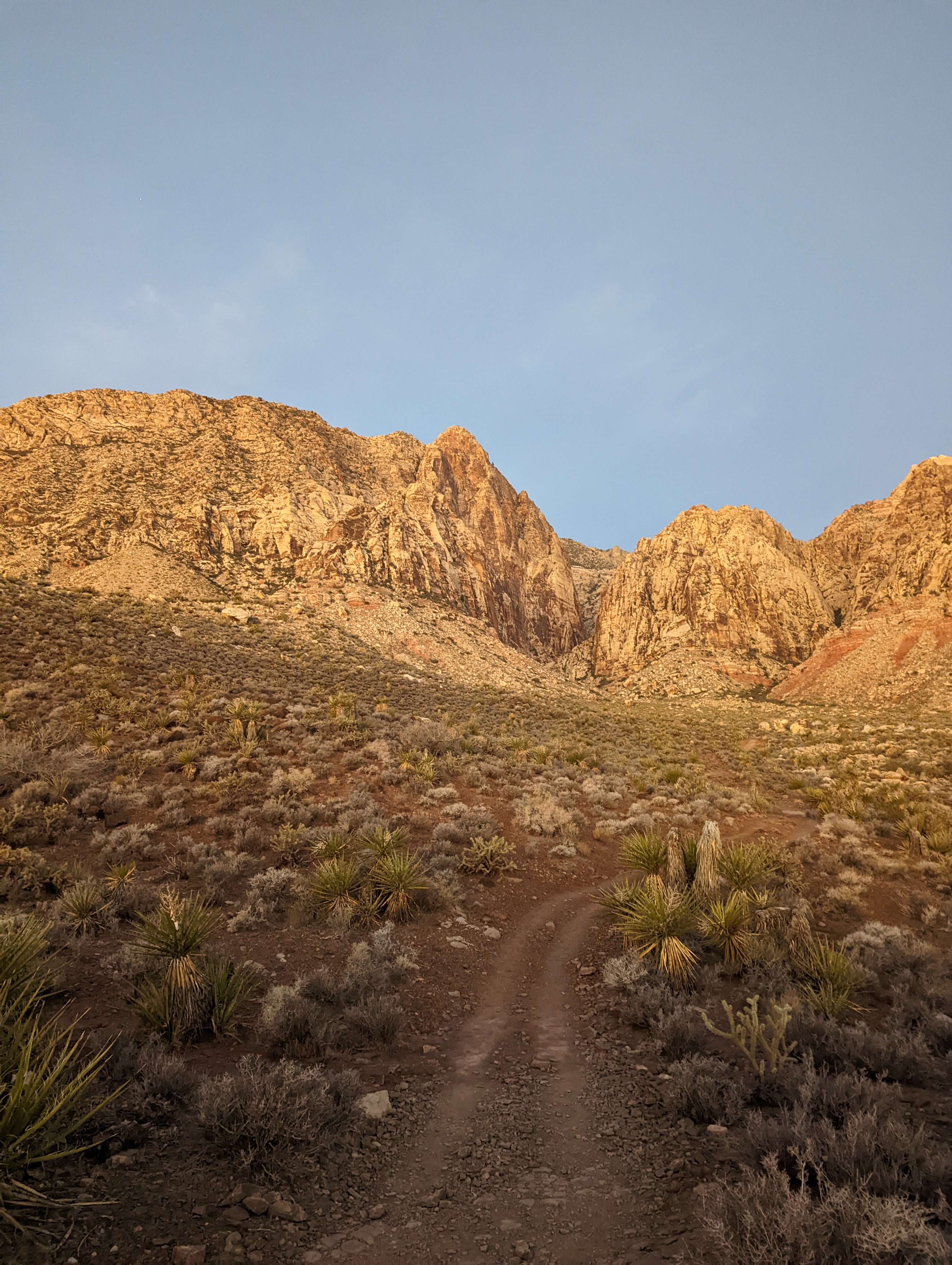 Hike in to Black Velvet Canyon
Hike in to Black Velvet Canyon
The wash leads to a 30-foot cliff which would be a roaring waterfall if it had rained enough recently. But, since Red Rock is a desert, we don’t climb after rains in Red Rock, and probably for other reasons, I’ve never seen water there. But, we have to get up that cliff to continue on to Epi. In climbing, we often ascend the vulnerabilities in the route - a crack, a face with holds, a less steep slab. To get up this cliff, there’s a less steep option a little earlier out the wash on the left. It’s about 30 feet of walking up a steep path to a 4th class 30 foot cliff that has some ledges and holds. If we fall off of the cliff at the worst time, we are probably falling 30-60 feet to Nevada stone. Some advanced climbers wouldn’t consider this climbing, but I think all non-climbers would.
My first time free soloing this cliff was with Du, Stephanie, and Liang when we were approaching Sour Mash in 2017, a 5.10a trad multipitch route near Epi. I remember back then thinking “woah, this is sketch” and “well, they’re doing it, and seem ok with it, so I’ll do it and be cautious”. We made it without incident. After Sour Mash, we also down free soloed this cliff. My first attempt of Epi was my 3rd and 4th times soloing this cliff. So, on this second attempt of Epi, this was my 5th time. By this 5th time, I understand the route enough to be focused but not scared. Experience breeds comfort. Climbers must be careful to maintain focus to counteract the natural drift towards unsafety.
When I talk with people about my passion for climbing, people often ask if I climb with ropes or if I ever free solo like Alex Honnold. Because it’s generally true (except this kind of situation on the approach to Epi), I say with confidence and a bit of a laugh to make them more comfortable: “No, I don’t have a death wish”.
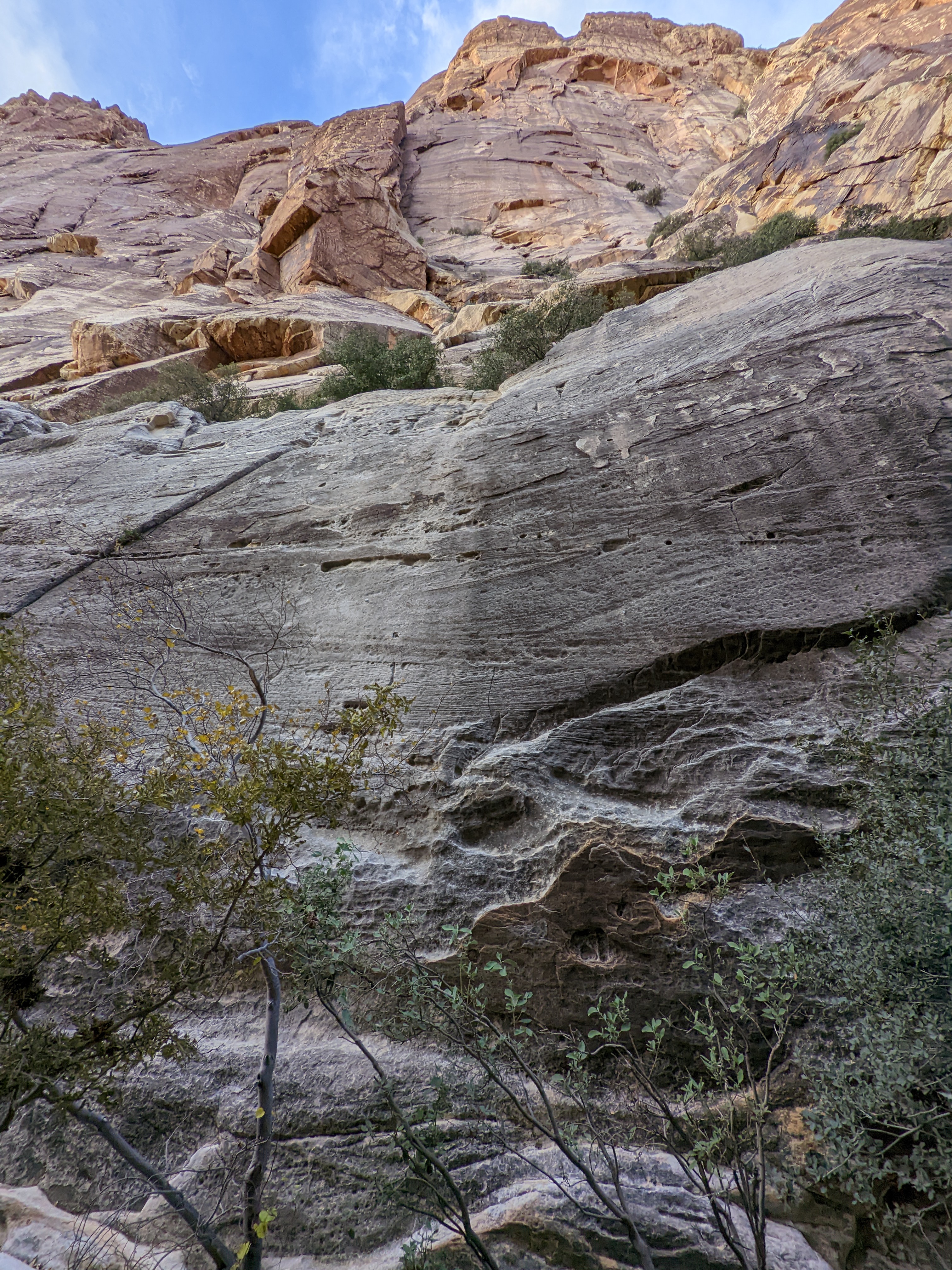 Start of Epi
Start of Epi
And, we did make it to Epi at around 7am. And, we were the first party! Yay!
We had also decided to do the 5.4 ramp on the right as Pitch 1, since the standard Pitch 1 is a thin 5.7 I had done in Feb 2022 when my hands and fingers were so cold they felt like they’d fall off. And, as Cody mentioned in https://www.youtube.com/watch?v=9rWFIDj-Tfk, there’d be a lot of this type of climbing higher up on the route. Luke and I were intent on getting through at least Pitch 2 (where we bailed last time), and ideally through parts of the Black Tower. So, we started gearing up.
Within minutes, we heard another party approaching us through the wash. As they got closer to the base of the route, it was clear they were going up Epi. So, I went over to chat with the two dudes. Confirmed: they were going up Epi, but they were taking a variation called Norepinephrine around the Black Towers. One of them had done the route many times and was a guide. So, we let them go ahead of us. This delayed us some, but not too much. But, the delay wasn’t an issue for us because we knew we were going to rappel whenever and we wanted to let any parties going higher to pass through as quickly as possible. It’s a long route and I didn’t want to be in others’ way on such a committing day.
So, the 5.4 ramp was new to both Luke and I. We wanted me to lead the pitch 2, so Luke started here. We weren’t sure if we’d be able to link from the ground to the first bolted anchors. But, we’d figure it out and, in the slowest case, Luke would build a trad anchor when the rope drag got too bad, and before he set off on the harder 5.7 parts to gain the first bolted anchor. So, he led the 5.4 ramp.
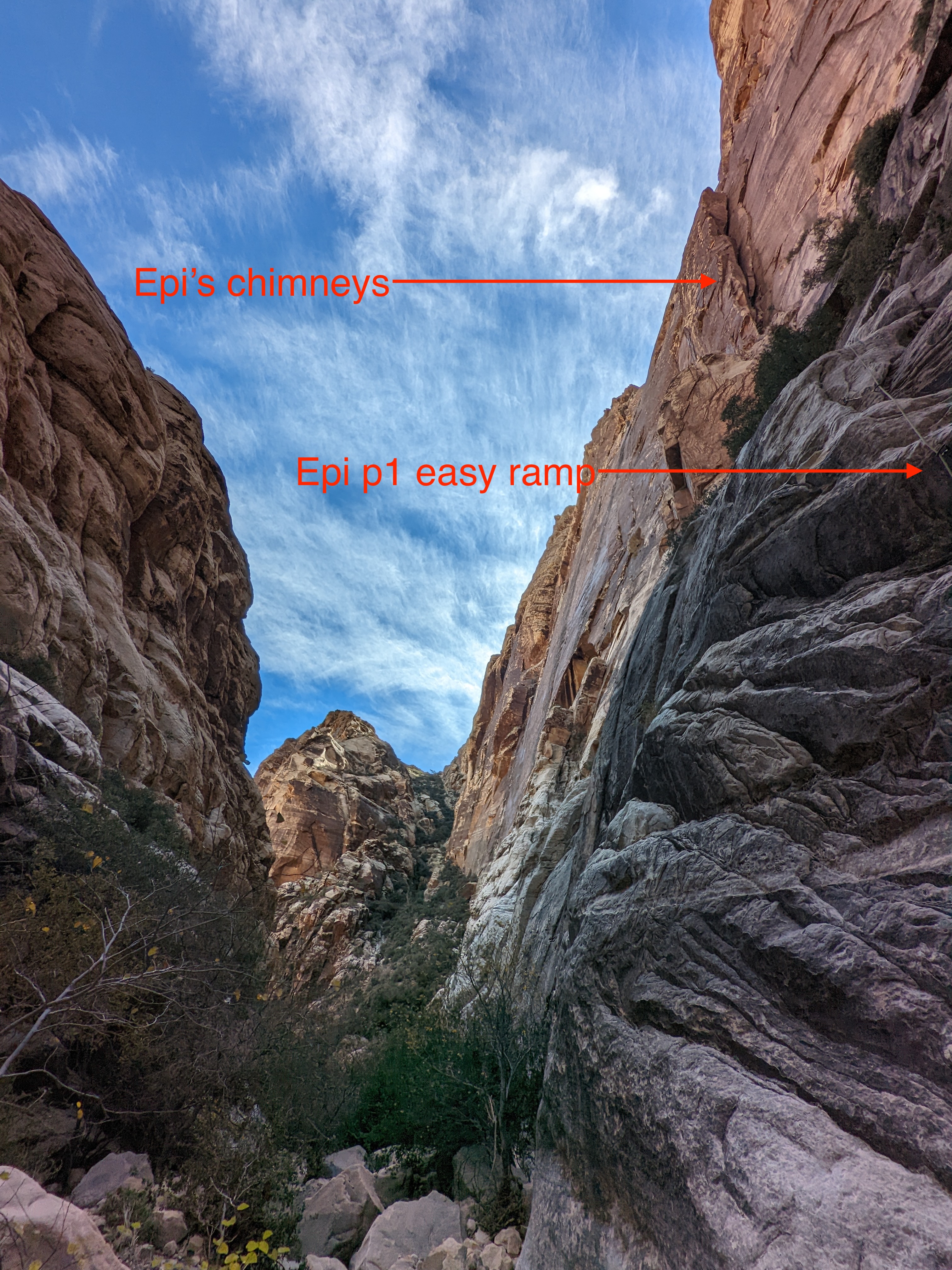 Epi p1 alternate start up easier 5.4 ramp
Epi p1 alternate start up easier 5.4 ramp
Not without risk, we left a lot of slack in the rope system on the initial part of this 5.4 ramp since Luke traversed far right to get on the ramp but I stayed put where it looked like he’d return and go back up. Additionally, the climbing was more like walking on a very narrow path and either didn’t offer a crack for him to place protection (cams or nuts), or it didn’t seem worth it. All of this combined meant that Luke was up 20-30ft off of the ground before placing his first cam. After getting the first cam in, he wanted to go left and up, but I suggested right and up. I think this caused a modicum of tension based on how he responded after my suggestion. I think Luke was a little nervous at this time, but I’m making an assumption because we haven’t talked about it yet. Luke made it up the right and placed another piece, and then gained the big ledge which didn’t need cams or nuts because Luke was traversing left by 50 feet, so the rope was going behind strong bushes that acted as natural protection. After a while, Luke called “off belay”, pulled the rope up, and I joined him.
Luke made a trad anchor after traversing left but before going vertical, because the rope drag was already bad. Had he gone vertical, the rope drag would have been even worse, and he’d have been on a more tenuous lead trying to hulk the rope up behind him. So, we swapped the minimal gear, put Luke on belay, and he was off again.
Later, I followed this section. I had done this section on lead in colder weather and a darker time of the day, so I knew I could do it. But, there’s something about following for me that can sometimes feel scarier than leading. I suspect it’s that I have the attentional capacity to spend on being scared whereas if I spend that on lead, I’ll undoubtedly make more mistakes and not have a joyous time. Am I actually scared-er on lead but not realizing it? On lead, am I suppressing or harnessing those emotions to focus and calm myself? Most of this pitch was smooth as I followed up. There was a small section of slab that I traversed where I felt a little scared and got very focused - though I was very safe on top rope - had I fallen, there likely would have been zero blood or bruise on my body only the mental injury of falling.
I made it to Luke, and anchored in.
2nd pitch
I was to lead the 2nd pitch because Luke tried last time in February. In addition to scouring books and online insights, this time, we’d asked the earlier party how to approach the 2nd pitch. With all of these points in mind, I knew I needed to come out of the chimney system to the face. So, I started making my way up the ramp to the chimney. I noticed a brand new anchor at the same height, just a little right of the anchor Luke setup. This was interesting: it wasn’t there in February, so it’s rather new. I noted it as a possible rappel anchor for our descent, should there be other parties on the climb. That’s nice. Thanks to whoever installed it.
I got into the chimney, and kept going for a while until it was narrowing. I saw some chalk to get out of the chimney, so I started out. I made it out and onto the face, found more chalk, holds and cracks to put in some protection. So, I made my way a little further to a good stance with good holds that were chalked. This must be the route. I looked up to confirm. But after observation of the next part, I reflected “huh, it doesn’t look like there are more holds or cracks above, maybe this isn’t the route”. But there was also a little bit of a ledge, the rock changed angle, so maybe I couldn’t see the holds.
I decided to place a piece to scope out my next moves. So, I wiggled in a small nut - my first piece in ~30 feet, and the first piece on the face since coming out of the chimney. As I looked forward, it seemed thin - not well protected with holds or cracks to put in gear. But, I was still thinking this might be the way, given the amount of chalk on the great holds coming out of the chimney.
So, I decided to match my foot to my hand and then mantle up and over the angle change by pressing my hand down.
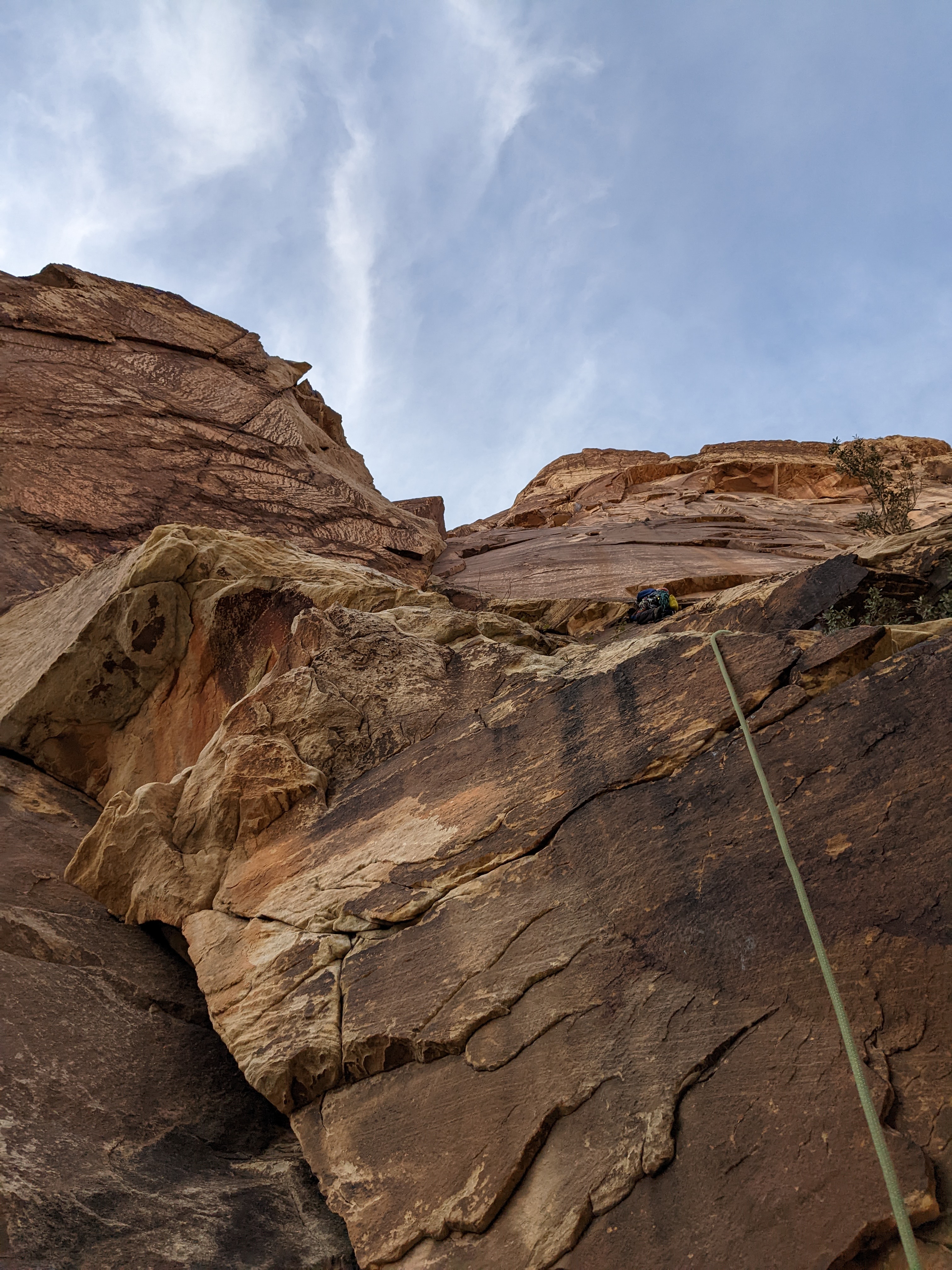 Jason on Epi pitch 2, right before going over the angle
Jason on Epi pitch 2, right before going over the angle
Tenuously, I got up.
Then I looked around more, and confirmed that there were no more holds or cracks. After a few moments of consideration, I decided to downclimb. Now I had to reverse the tenuous mantle move, remove the small nut, traverse 10 feet to the chimney and climb 10 feet down into the chimney. I made it just fine. I went a little further up the chimney, found another place to come out onto the face. After rising out of the chimney to the face, it was obviously much easier than the previous face option I explored. This way had cracks and jugs. I continued up to an easy ramp, placing my number 5 camelot and other smaller gear along the way. The anchors were in an obvious spot, and by the time I reached them, I had a fair amount of rope drag from the right turn out of the chimney and left turn up the ramp, and the final right turn back to the anchors. But, I was at the anchor and safe.
Luke followed my lead and as he was making it to me, I could see the party below him not too far away from him.
Letting a party pass
As Luke arrived and got safe, we discussed and agreed to let the party pass, since they were planning to summit and we weren’t. So, Luke and I hung out longer than planned, getting colder by the minute, but also seeing just how difficult the chimney above could be, especially when choosing the offwidth chimney path on the left side.
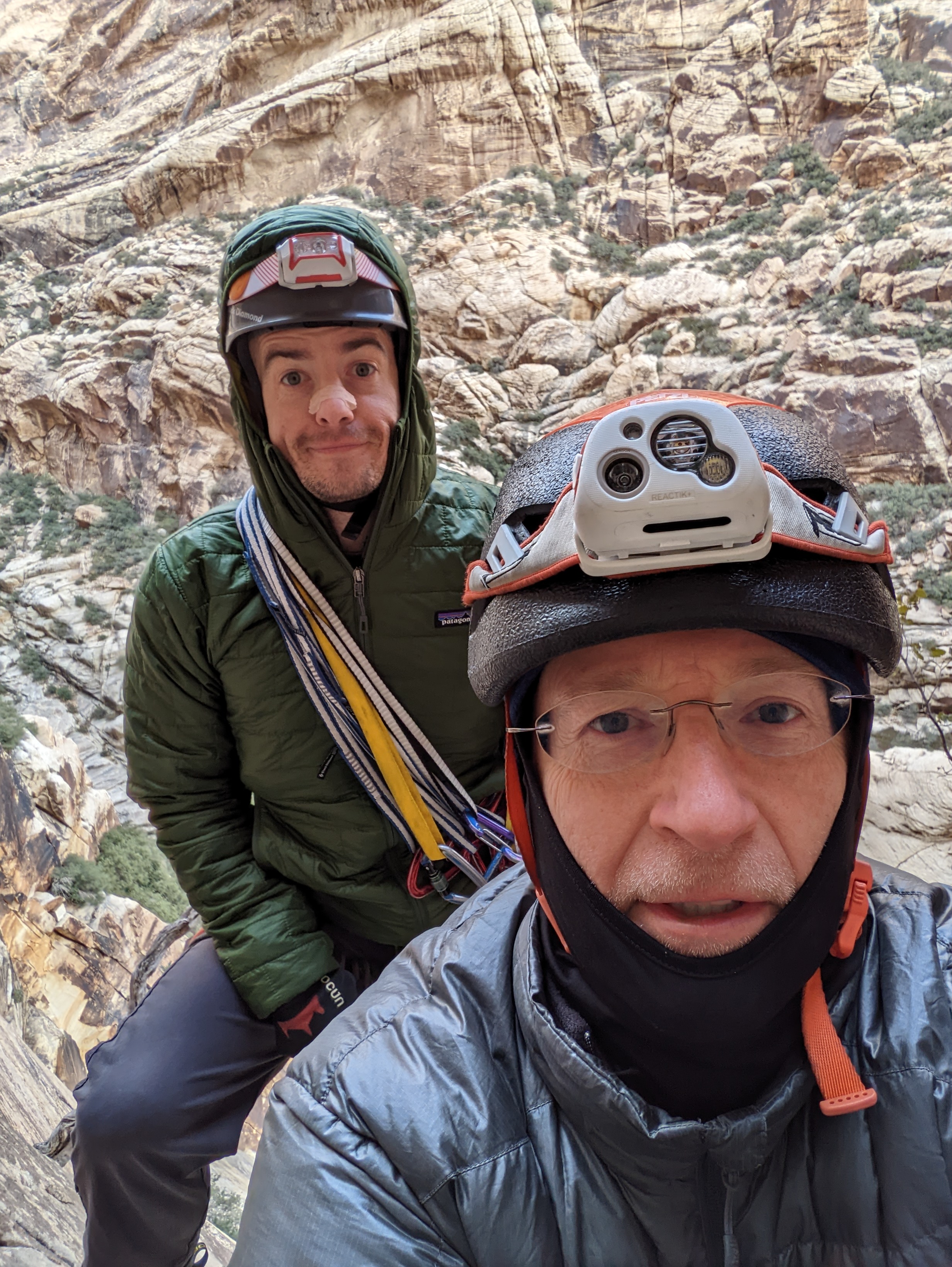 Start of Epi pitch 3, getting colder by the minute
Start of Epi pitch 3, getting colder by the minute
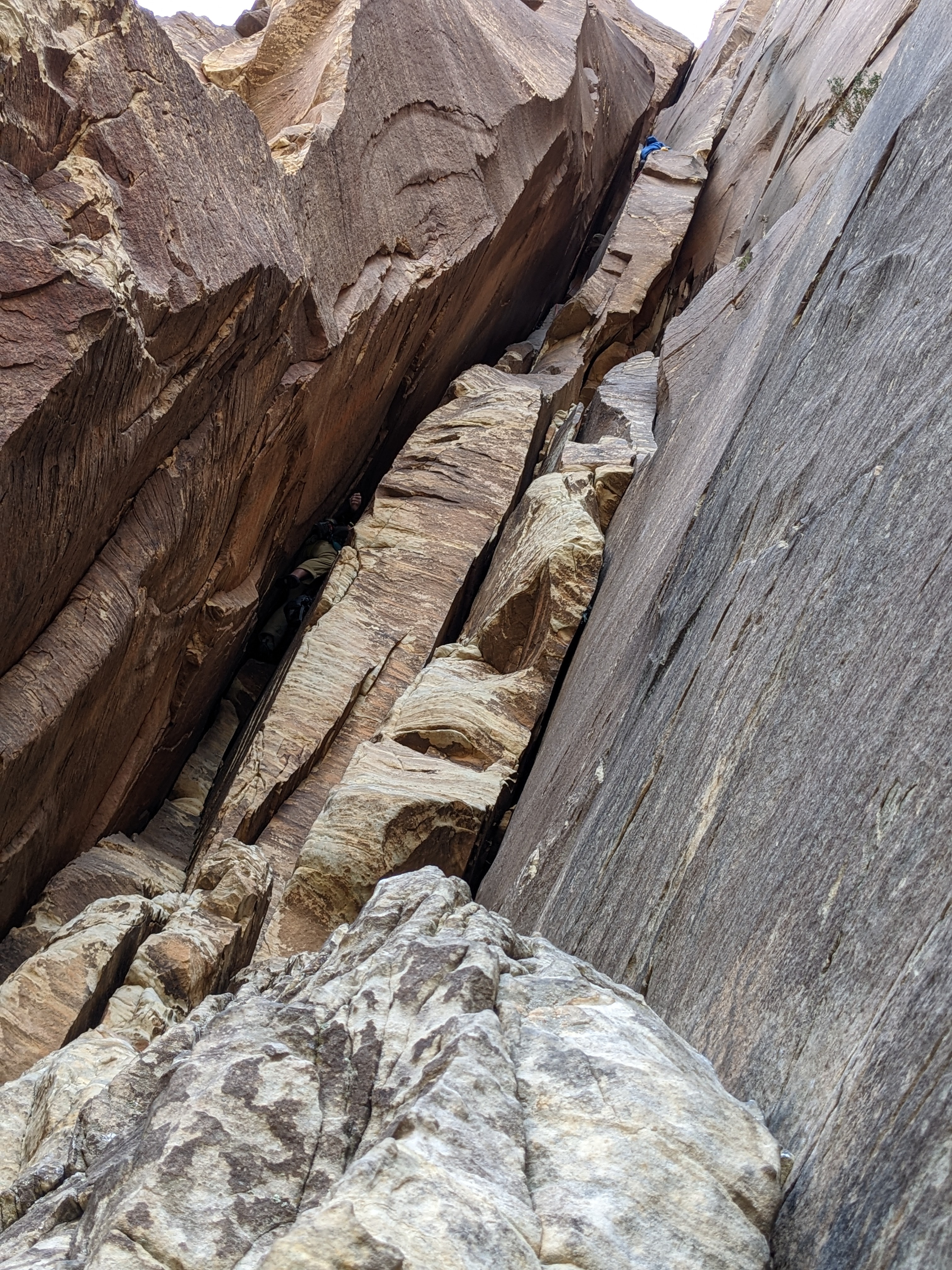 Epi pitch 3, the squeeze chimney way - it took them 90 minutes to get
through
Epi pitch 3, the squeeze chimney way - it took them 90 minutes to get
through
3rd pitch
After at least 90 minutes of being at this anchor, the party ahead was finally far enough ahead that I started the 3rd pitch. Luke and I had watched a video from Cody that told us to stay right to avoid the offwidth for as long as possible, so that was my plan.
There was one section towards the beginning where crossing to the right face was a little difficult. I reached high and cut both feet in order to hike myself up to a ledge on the right face. This was probably the hardest move of the route so far. But, I made it! And I balanced my way up to standing on this ledge, walked forward and shimmied through two flakes, and after a little more easy ground was able to reach the chimney.
Switching from the ledge into the chimney was a little difficult since my body was on the right but needed to flip around so my back was on the left. But, again, I made it :) Now I was in the chimney and had about 30 feet to go to the ledge with the anchor. For the rest of the way, I used a chimney climbing technique with my back on the left wall, knees on the right wall, feet mainly left but sometimes right and my hands mainly right but sometimes left. The sometimes movements of my hands and feet were so that I could press myself up. This worked well enough, but was exhausting :) As I neared the top, a crack opened up in the back. As I was transitioning towards this crack, where there was a kind of seat in the middle of the chimney that formed the crack, my foot slipped and I kicked one of my cams. But, I was able to press myself into a position to stop falling. The party above called out something encouraging to me. And I pushed to finish the transition to a secure chimney position.
Rattled and fatigued, I asked the party above how they finished this section, and they said they fist jammed in that crack. Insecure, I said that’s not my comfort zone yet and just muscled through the rest with the chimney approach. But, I made it! I set up our anchor, and our hauling system with the Roll-n-Lock, and hauled up our packs to the top of the third pitch.
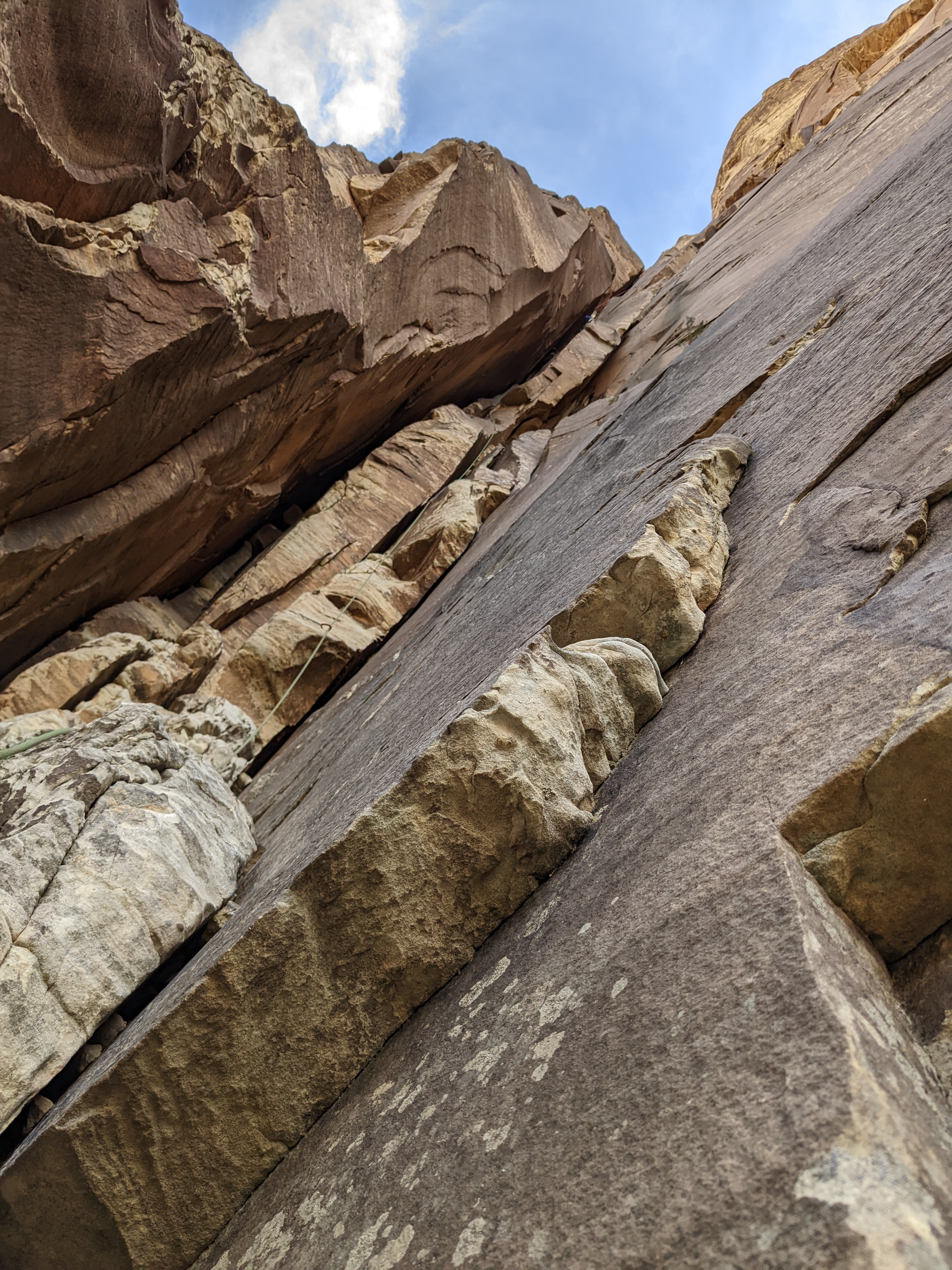 Epi pitch 3, notice the rope staying out of the lower offwidth
If you zoom in, you’ll see a blue climber and red rope above us, I am below that
in the dark part of the chimney :)
Epi pitch 3, notice the rope staying out of the lower offwidth
If you zoom in, you’ll see a blue climber and red rope above us, I am below that
in the dark part of the chimney :)
Hauling & Luke’s follow on pitch 3
This was the first time Luke and I hauled together. The packs got caught at one point, so we lowered them so they’d be in free air again, and then I raised them with my strength rather than on the Roll-n-Lock. After getting them high enough, I pulled the slack through the pulley and continued using the pulley. In hindsight, I didn’t need to pull them by my own strength for that long. I think of this as a sign of fatigue, a drift towards unsafety.
Luke followed, commenting at all of the parts that were difficult for me, and easily using the fist jam technique towards the end. I noted to myself that I’d like to practice this technique more :) since I didn’t choose to attempt practice while leading this pitch. [Note from January 2024: Happily, Mesa Rim Austin opened in March 2023 and I’ve since practiced fist and hand jamming much more!]
Luke arrived at the belay.
Deciding to bail
Feeling scared, tired, cold and proud but wanting physical warmth from sunshine on me and daylight to guide us in the exit, I proposed that we rappel. Luke didn’t need much convincing. So, we disassembled the haul line, and started rigging the rappel. The haul line was actually a double/twin rope, so it was thinner than our climbing rope. After tying the two ropes together, Luke used a technique to secure the double rope to the anchor point by tying an overhand on a bight on the thin rope just below where the ropes were joined and then clipping the overhand to the thicker rope. Since the ropes are different sizes, the friction in our rappel devices would only be on the thick rope. So, if we weighted the thick rope without this securing technique, the thick rope would just be pulled down and we’d fall. With the overhand and clip across, when the thick rope is pulled, the small rope bight holds everything at the anchor. But, after rappel, we pull the thin rope and the thicker rope just pulls through, so we can retrieve the joined ropes (and biner). I think this rappel was the first time I’ve used this technique, so I felt a little nervous, but it was easy enough to test at the anchor (and we had discussed it the night before).
Once the ropes were set up at the anchor, we continued with our standard rappel process. Tie figure 9s at the end of the rope so we never rappel off of the end of the ropes. Coiling the ropes was a little annoying given they were floating about in the 15mph wind. Further, when it came time to throw the ropes, only went about 10 feet before being blown back into the side of the mountain. With the ropes down enough, I set up my autoblock that I use when rappelling to both slow the rappel descent speed and act as a hands free backup in case I let go of the ropes - the autoblock will grip the rope and prevent me from continuing down. Then I pulled up some slack to ensure the autoblock would hold the rope, it did. That gives me enough slack in the higher part of the ropes to connect my rappel device. So aside from the wind, this portion of the rappel was normal. I rappeled first. During rappel, I had to throw the ropes a few more times because the wind resisted my attempts to have the ropes land at the next anchor. But, I made it back to the top of pitch 2 anchor.
I stood comfortably on the boulders, disconnected my autoblock, took out my belay device, and yelled “off rappel”. Then I looked down, and realized I had made a mistake.
The rappel mistake
I forgot to attach my harness to the anchor before coming off of the rappel.
For a few seconds, I had been unattached 320 feet off of the ground. Had I slipped or stepped back or leaned back, I would have surely died.
In that unattached moment at the anchor, I didn’t feel a rush of adrenaline that comes with fear or uncertainty. I knew exactly what needed to be done. So, I quickly unclipped my tether from my harness and clipped into a bolt. I was secure again.
I secured a second tether to the other bolt, and let Luke rappel to join me.
Once Luke was anchored next to me and confirmed he was secure, I told him of my mistake.
He looked at me, leaned over, hugged me and said “I’m so glad you’re ok”.
We still had 2 rappels to do, so we moved on to the tasks at hand.
New rappel anchor
Luke led the next rappel. He anchored at the new rappel anchor that the one of the servicemen had told us was aluminum. The new anchor is a little easier to get to. I arrived second and, of course, anchored myself to each bolt.
We took care to flake the ropes before the final rappel, and used big bombs for each rope strand. Luke rappelled to the ground without twists or kinks - smooth like butter! I followed like butter as well, with the small exception that I saw the ropes draping over the branches of a bush at the final ledge, about 50 feet from the ground. I was able to remove one rope from the bush, but decided to deal with the other rope from the ground.
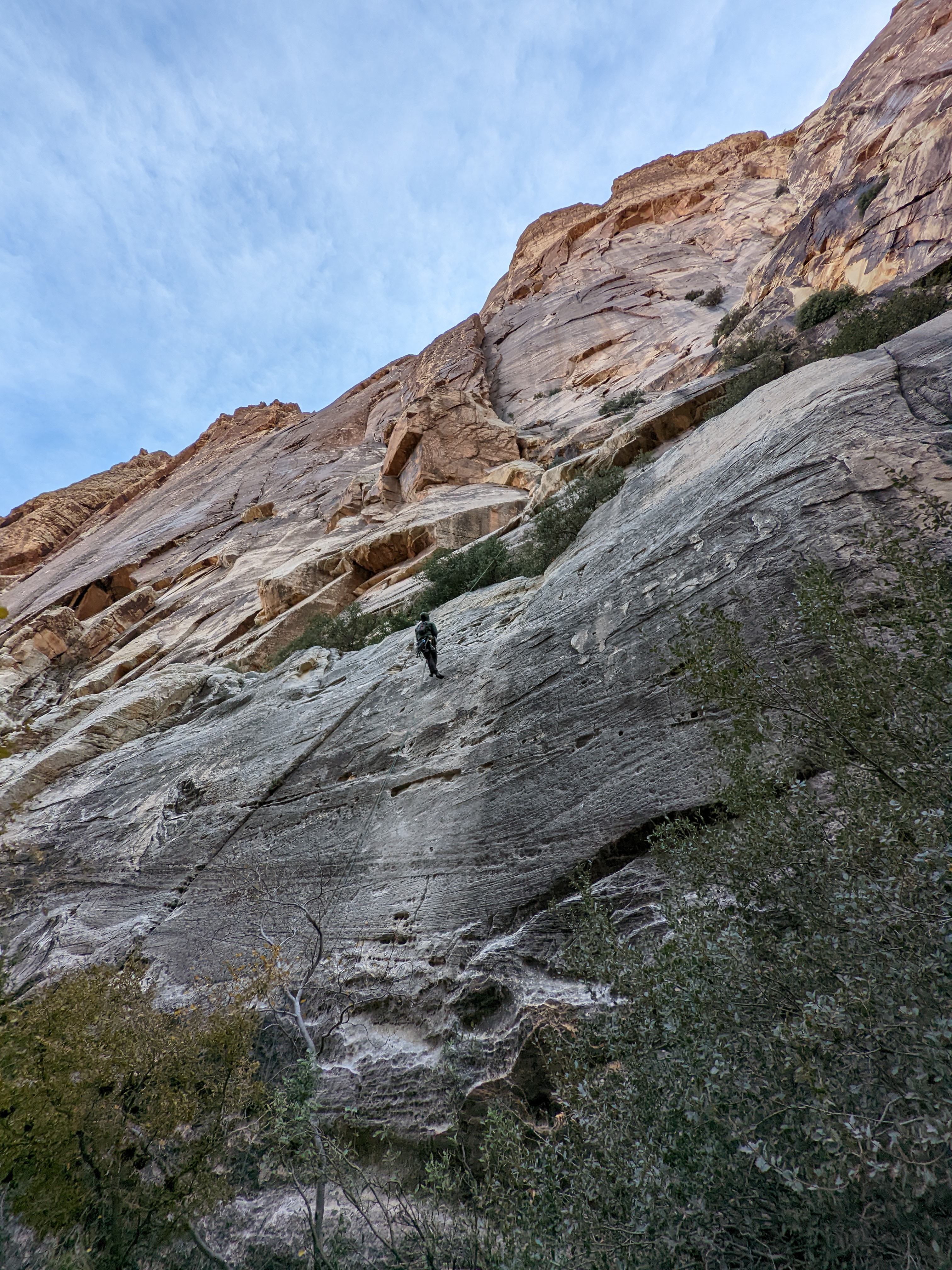 Me finishing the epi rap, evaluating the ropes in the bush
Me finishing the epi rap, evaluating the ropes in the bush
And wow, did I feel relieved to be on the ground.
As Luke pulled the rope, it was difficult. We both grabbed the rope to combine our power, but after minutes of more than normal strenuous effort, we weren’t able to get the rope to budge. We noticed that it twisted upon itself. We tried using Luke’s Roll-n-Lock and a sling to help us pull more, but no dice. Luke even tried to solo up the other side of the canyon to get a higher angle to pull the rope, but again no dice.
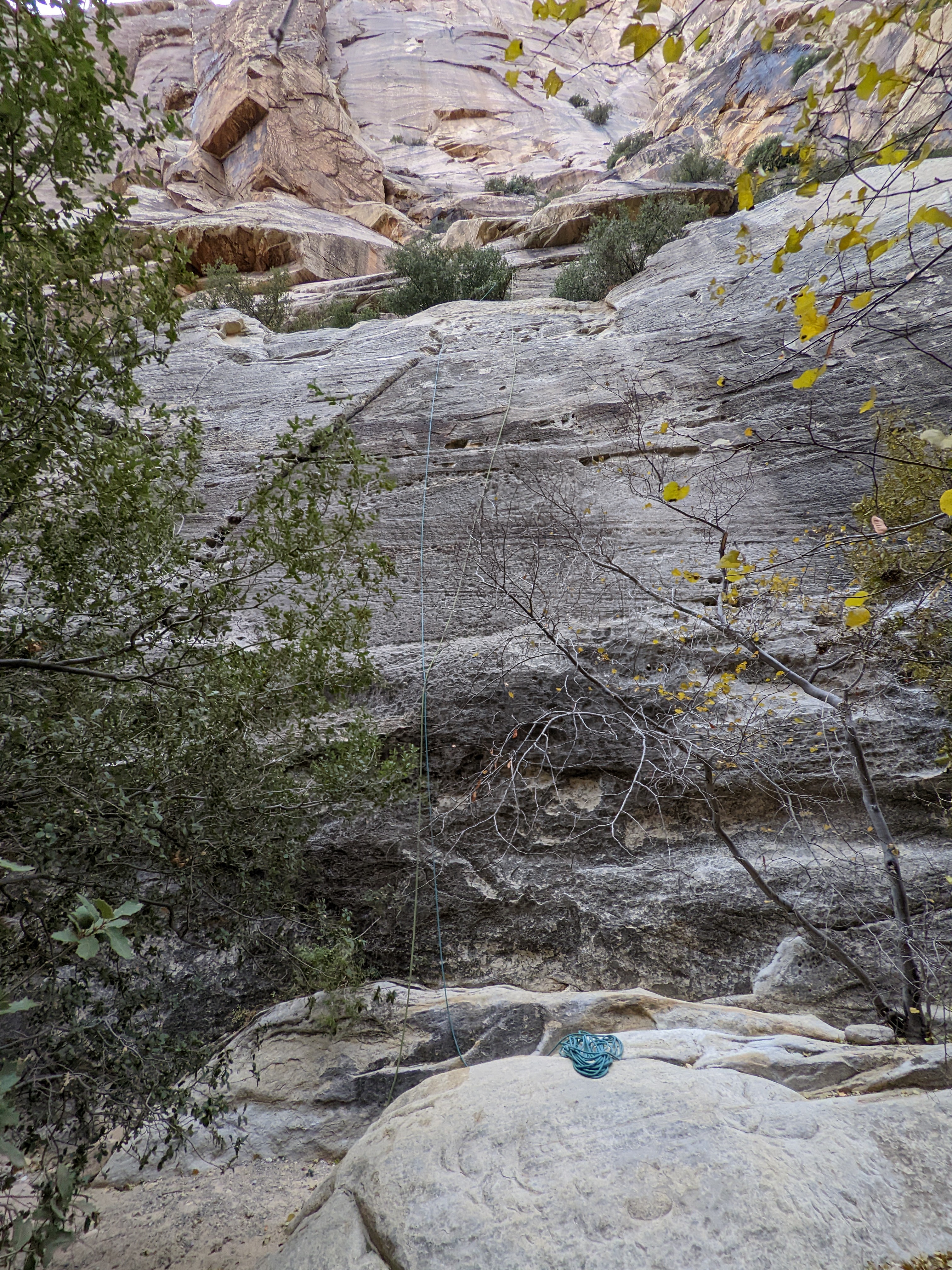 Our ropes stuck on the last epi rappel
Our ropes stuck on the last epi rappel
We ran through options including ascending the stuck ropes, coming back the next day with more gear, and just leaving the ropes. We decided to borrow a rope from a friend in town and come back the next day.
We continued with tasks til bedtime - getting the rope, eating, driving, preparing for the next day. That night as I closed my eyes for bed, my mind raced and I felt myself swimming and oscillating through the what-nows. Do I talk about this with Mar? Will I climb again? Why do I climb? Is climbing worth it?
Epinephrine Rope Rescue & Schaeffer’s Delight - Thursday
Since we assumed retrieving the ropes would be quick, we planned to climb the 3-pitch Schaeffer’s Delight after retrieving the ropes.
We decided to come back to Epi later than the previous day to give Epi climbers the space to start the ascent of their longer days.
Since we had a lot of time on our approach to Epi, we made Gaia GPS waypoints with photos to guide our future selves. These waypoints were insurance, because we got off trail on this path back to the car on our February 2022 trip and hiked out differently than we hiked in on the day before. I felt grateful we took the time during this trip to mark the points - we’ll be able to use them on all future trips.
As we got over the 4th class free solo cliff near the end of the approach to Epi, I heard climbers. So, I ran to the base, to be sure I could talk with the climbers on Epi before they were too far away. I got there, and they confirmed that a rope was on the ledge - cool! So, I went back to ensure Luke was doing alright - he was. I shared the good news that the rope was on the lower ledge. This was nice because it meant we didn’t need to unstick the rope, just retrieve it from the lowest ledge about 50 feet up from the base of the canyon. Someone else did the work to unstick the rope - yay!
I led the 5.4 ramp placing 2 cams before gaining the ledge, where the bushes protected the left traverse. I made it to the rope, set an anchor, and brought Luke up.
However, there was just one rope, not two ropes and a carabiner. So, a party unstuck our joined ropes, and a party took one carabiner and one rope (the newer 60m double/twin).
We got back to the ground without incident. We discussed whether to go do Schaeffer’s Delight. Luke was ambivalent. Since we’d been talking about authenticity throughout the trip, Luke explicitly called out to me that now was a chance for me to be fully authentic - I could choose to climb, or not. I let myself consider the possibilities. I felt at peace already, I didn’t feel eager to climb, I didn’t feel scared to climb - I had just easily led the 5.4 ramp without fear. I longed for the sun - surprisingly, we’d been in the desert for days but not felt the warmth of the sun. So, I opted to picnic in the canyon, follow Luke’s desire to explore up-canyon some, get back to the parking lot to bask in the sun, and generally turn in earlier rather than later.
And, so we did. And it was so pleasant. Unbeknownst to us, further up-canyon, we were able to clearly see climbers on Epi.
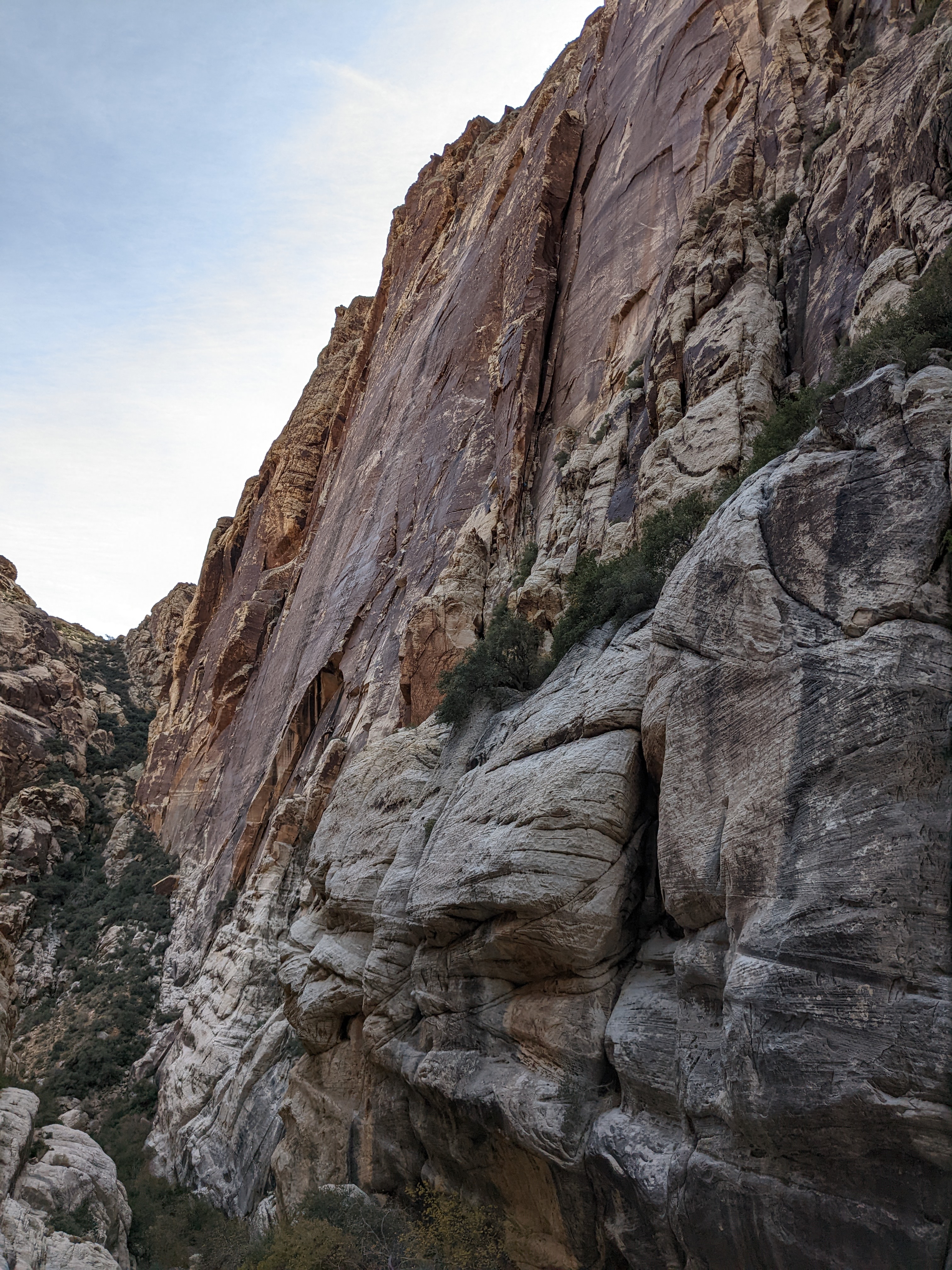 Epi from up-canyon. It’s the chimney system in the center of the picture
Epi from up-canyon. It’s the chimney system in the center of the picture
So, we stayed in that part of the canyon for some time eating snacks and watching them, which was quite enjoyable. It seemed like quite a cluster up in the chimneys - we saw a lot of ropes and people stationary for a long time.
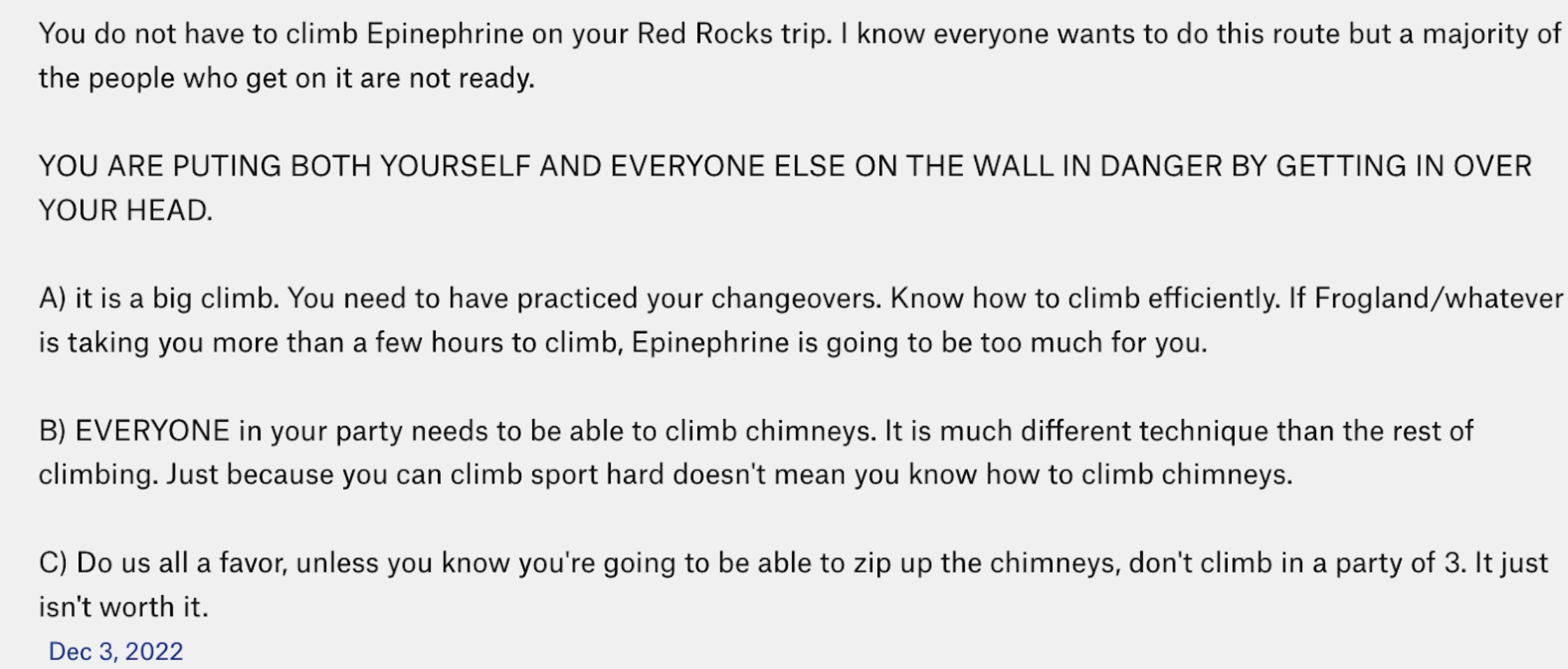 I think that one party from that day posted about Epi congestion on Mountain
Project, perhaps a party behind the slower ones?
I think that one party from that day posted about Epi congestion on Mountain
Project, perhaps a party behind the slower ones?
We used our Gaia waypoints on the return to the car :) even though we didn’t really need them. And during our lunch in the sunny parking lot, I felt serene with the warmth, beauty, nourishment, and sense of accomplishment. Even though there were some near misses.
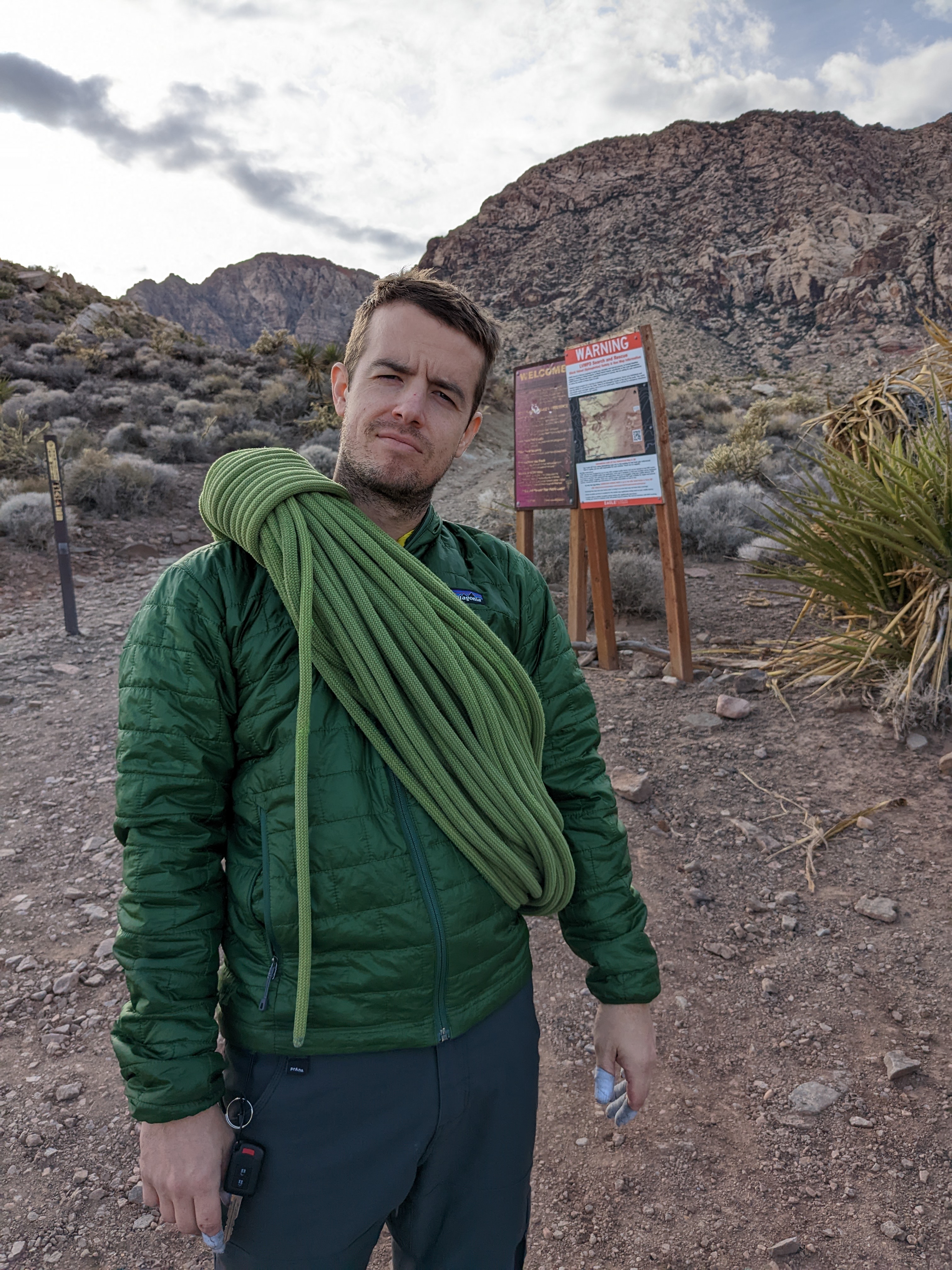 Jason with our friend’s rope
Jason with our friend’s rope
We returned the rope to our friend and went to the hotel to pack and sleep a few hours before our early morning flight.
Again, as I laid down to bed after a day of continuous activity, I wondered about the rappel mistake and its implications. Why bother to climb trad multi-pitch? Is the benefit worth the risk or cost? How will I talk to Mar and others about the near miss? Will I stop climbing?
Returning home - Friday
We returned the car and boarded our early morning flight without issue. On the plane, I read, and Luke slept. Eventually, I wanted to sleep, so I closed my eyes. However, again, my mind raced on my relationship with climbing.
Rather than toiling in my head, I opened my eyes, got out my journal and started writing a synopsis, asking myself questions and answering myself. I felt remarkably better after taking the time to hash that out.
- Could I have unweighted the rope and fallen if I was at a hanging belay? No
- Will I ever make this rap mistake again? Probably not since I’m so sensitive to it now
- Will I multi trad again? Yes
- Why do I multi trad? ** Self Responsibility ** Challenge ** Beauty ** Commune with nature ** Aliveness ** Presence ** Learning ** Growth ** Movement
- Why not? ** Family ** Death
After we de-boarded the plane and were making our way to baggage claim, I mentioned my mind toiling to Luke. He acknowledged my point, but we didn’t dig into a conversation.
My mom picked Luke and I up from the airport. Luke and my mom talked the whole way back to his house and I wasn’t ready to tell my mom just yet anyways. (Actually, as of this writing on 2/5/23 [and 1/24/24], I still haven’t told her). We dropped off Luke. My mom and I had some lunch.
I made my way home. Mar and I left home to go get some coffee, I told her about my mistake and our rope twisting. She was instantly all of the responses:
- Oh thank goodness you’re ok.
- You know you can just focus on sport climbing, right
- Well, I do want you to do what you want.
- But trad climbing scares me.
Being known
In the following days and weeks, I told all of my climbing friends, multiple non-climbing friends, and some colleagues, and heard a variety of responses:
- Oh shit, glad you’re ok
- Yea, trad climbing is dangerous
- Climbing is safer than other things
- (Implied but never stated out loud) You shouldn’t climb
- (Only from climbers) You should keep climbing
Through all of my conversations with people, I oscillated through different
- Refreshed and empowered to continue a style of climbing (multi pitch trad) that I’ve very much enjoyed and that meets many of my needs
- Annoyed at the dismissals of my enjoyment. Rajkumari Neogy taught me that we receive people’s dismissals and advice giving reactions as physical pain if they’re given before we’re ready.
- Torn between the different perspectives - not just other’s perspectives but my own too
Reflections
I greatly appreciate Accidents in North American Climbing and Ashley Shaupe’s Sharp End podcast as I’ve described in https://www.learningfromincidents.io/posts/how-to-be-better-together. What follows are my reflections on the trip’s accidents, injuries, and emotional reactions. I welcome further reflections on what went wrong and what went well so that we can all be better climbers.
Recent experiences led to fixation
The previous rappel experiences in the week on Community Pillar were nearly all humongous ledges where I came off rappel, and walked tens of feet to the next anchor without being tethered. That I skipped so many tethers on Community Pillar, the most recent rappel experience before the mistake, most definitely contributed to my fixation to this process during the Epi rappel. My muscle memory had adapted to skipping the tether when there was ample ledge space.
Preventing the rappel mistake
I don’t think this type of rappel transition mistake could have been possible at a hanging belay since I would have been putting weight on the rappel device. So, I feel safe when considering this perspective. However, what about all of those rappels with a ledge, like my rappel mistake here?
Of course, I missed a step in the normal rappel process - clipping my harness to the anchor before taking myself off of the rappel setup. Why? Process fixation is one hypothesis. Fatigue and discomfort are others. It could happen to any of us, so how do we prevent it from happening? Other than remembering, I’m not sure of another “fix”. It’s up to each climber and climbing team to decide if the rewards are worth the risks.
Emotions and feelings are team players
Fortunately, emotions and feelings are team players: easily and automatically present to guide us when needed. I hypothesize that in my future I’ll gently drive myself to heightened awareness and focus on safety during rappels, because I will always remember feeling fearful, confused and grateful from this experience. My bodymind will bring these feelings forward in future rappels, whether I explicitly and logically think of the specific experience or not.
[Note from January 2024: Indeed every rappel since this mistake I’ve performed at least two checks of the process, ideally by both me and my teammate]
Experience breeds safety
“Practice makes better”
Early in my multipitch days, I remember being pretty scared to move on ledges, or even hanging belays. I wanted to reduce the pull on the anchors as much as possible. So, when I had a ledge, I’d stand on it, and try not to pull on the anchors unless necessary. Perhaps this fear-based adaptation to be still or very slow on ledges contributed to saving me here. It wasn’t a conscious thought in that moment of “Oh, I’m on a cliff ledge, I’m going to be cautious and slow” - that was my default and unconscious operating method.
Another potential life saving adaptation is that I knew this ledge from being on it for 2 hours and didn’t want to move from the secure location I had previously. Therefore, after the rappel, I wasn’t exploring - I was glued to the cliff.
“I feel relieved to be on the ground”
Reaching the ground after the Epi rappel mistake wasn’t the first time in my climbing years when I felt relieved to reach the ground safely. I remember getting to the ground after Crimson Chrysalis, and saying “oh terra flat-a’' which was an expression of gratitude for being on the ground. The statement after Crimson wasn’t the first time I’d heard or said that either - I had heard the phrase “terra flat-a” from Luke, I think. However, on this day at the base of Epinephrine, it might have been the first time I’d taken this one step further and tried to unpack the rush of gratitude. I asked Luke, “Why do I normally feel so grateful to be back on the ground after climbing, and especially after rappelling?”
Being safe is in contrast to being unsafe. When unsafe, we have our emotion of fear that urges us to navigate to safety. As climbers, we must learn to be safe with our movement, the rock and our rope system, or our fear would prevent the joys of climbing. But, that does not mean that climbers climb without fear.
I take the relief of the ground (or a good hold, or the anchor, etc) to mean that fear is present for me while climbing and descending - even if I can’t (today) detect the fear until I feel grateful.
Perhaps the relief of the ground is also latent relief, pent up from mini-fears throughout the day, that all get to release in a combined push now that I’m in a much safer spot.
Ropes twisted upon themselves
Our ropes twisted upon themselves after the final rappel to the ground. How’d this happen?
We both rappeled without any kinks or twists in the ropes - I remember thinking wow this is such a smooth rappel relative to the earlier windy rappels that day. So we think the twists occurred after the rappel, when we pulled the ropes. Why?
Our primary hypothesis has to do with the way the new rappel station was anchored to the cliff. It looked similar to this anchor:
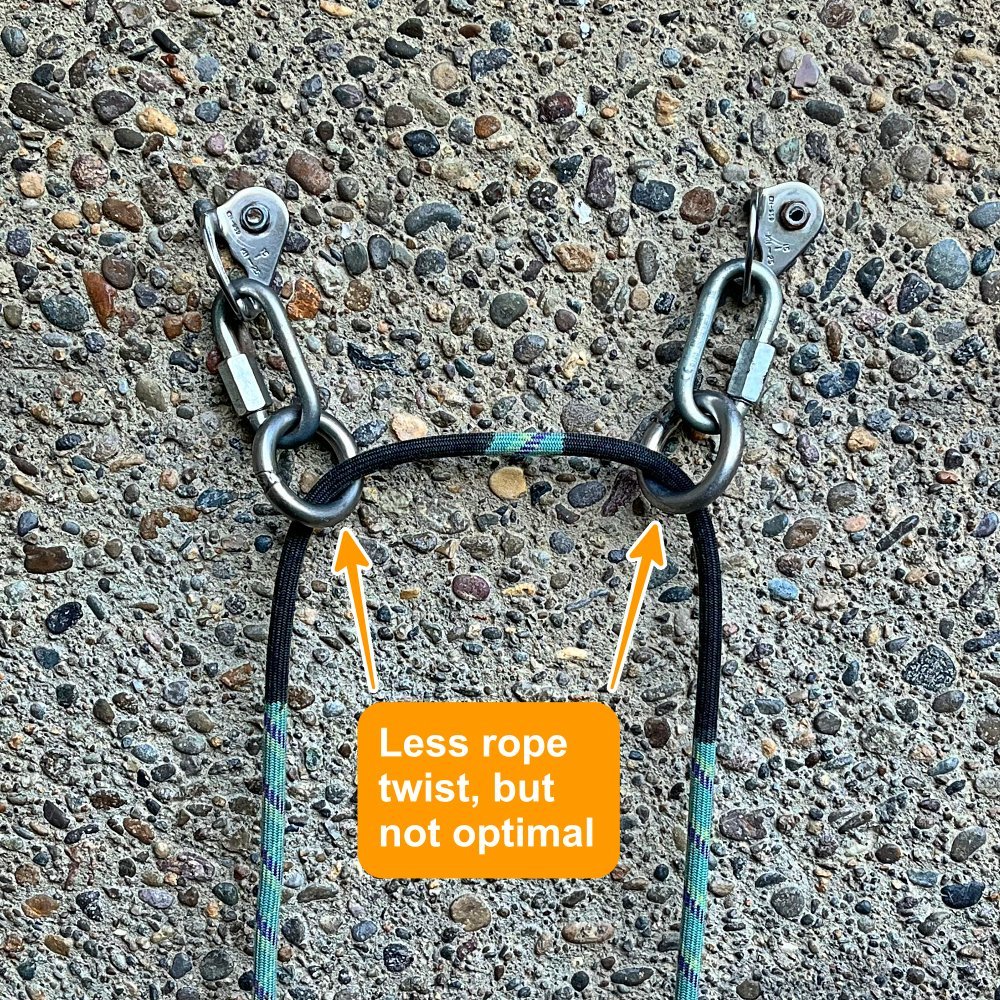 Rope twist risk from
https://www.alpinesavvy.com/blog/anchor-induced-rope-twisting
Rope twist risk from
https://www.alpinesavvy.com/blog/anchor-induced-rope-twisting
Additionally, I wonder if our joined rope system contributed to the twisting. Our ropes were different sizes, so we clipped the joined ropes together to temporarily fix the joined point at the anchor. If we hadn’t clipped them, the rappel device would have pulled the fat rope down (because it has nearly all of the friction), causing the skinny rope to go up and through the anchor and we’d fall. It’s possible that this temporary rigging contributed to less rope maneuverability and thus contributed to the twisting.
Rescuing a stuck rappel system
We were fortunate that our stuck rope happened after both of us made it to the ground. But, this same problem could have happened on a higher rappel where we would have been stuck. What could we have done, had this happened higher up?
Rescue team
We could have called emergency services in the area to request emergency support. Bringing more people into the active rescue operation is always the last resort to protect and preserve the precious rescue teams for the most severe emergencies. We certainly would have exhausted all other options before asking the rescue teams for support.
Another climbing party
If there were other climbers on Epinephrine, we could have asked them for help. Some people may be willing to sacrifice their objective to help others. In our case, we were the last party of the day - we’d let 1 party start before us, and 1 party pass us. It’s possible that we could have yelled up to the party above us, but by that point, they were at least 6 pitches up - it’s doubtful they’d hear us.
If there are no other climbing parties on the wall, there’s also the possibility of waiting until the next party arrives. Obviously this depends on the likelihood that another party will come within a reasonable amount of time. We were on one of the most popular routes in the USA, so we did assume there’d be at least one party the following day. But, it would have meant an unplanned overnight stay on the cliff in cold windy weather, without the amount of water and food that we’re used to. Probably 1 day would have been fine for us - we had layers, and emergency blankets. But it would have been rough. If the route were less frequented, this option would have been less viable. For example, if we hadn’t seen other parties climbing the day we climbed and the route was less popular, maybe it would be another 3 days before the next party.
Self-rescue
Being able to rescue ourselves would be ideal. The main constraint with self-rescue is knowing how to perform the self-rescue! At this point in my 8 years climbing, I did not need to know how to self-rescue a stuck rope, so I didn’t! This is common in climbing, and more broadly everywhere in life. There’s a fundamental tradeoff between thoroughness and efficiency - we can’t do everything given our constraints on time and our multiple competing goals and priorities. However, Luke had experience that we would have used if it was taking too long for another climbing party to show up.
Since this experience, Luke and I reviewed the Climbing Self-Rescue (2nd edition) by Faruso - I’d brought a physical copy with us on the trip. So, I felt comforted to (begin to) familiarize myself with a rope rescue process.I also bought the ebook edition of Faruso and added “download self-rescue ebook” to my climbing packing anylist, so that I’ll always remember to have the book with me on my climbs. Of course this requires me to have my phone with me and working on my climbs, which is typical. So, this is an added layer to add safety margins to our climbing system.
Of course, it would be even more ideal if we learn the process, practice it, and repeat over time to more experientially code this capability into ourselves.
Lastly, in addition to reading the book, of course there are other options to learn and practice from the broader community such as other mentors, books, hiring a guide, or and even becoming a guide.
[Note from January 2024: In the summer of 2023, Luke and I practiced multiple rappelling and ascending self-rescue skills from the online course at https://www.vdiffclimbing.com/ and Faruso’s 2nd edition to add tools and practices to our tool belts.]
Community is supportive
For years, I’ve enjoyed the community support aspect of climbing. At the climbing gyms in town, friends and other gym goers are encouraging and welcoming. Most people need a partner to climb on ropes, in order to belay each other. I’ve been lucky to find mentors to climb with, from whom I’ve learned immensely. I appreciate all of these aspects of climbing because I believe that they’re connective, they’re community building and lead to a group of people who support each other more than they isolate from or compete against each other.
In this Red Rocks trip, community support continued in everyday ways which, I believe, really add up to a huge support network:
- Family and friends listening to my story helped me work through the confusion.
- Before talking with others, I wasn’t sure of my climbing future. Talking with
- others brought me out of my amygdala where I was swept up by the emotion of
- fear and feelings of bewilderment and into the part of my nervous system where
- memory has timestamps. Acknowledgement and warm accompaniment do wonders. Our
- friend lent us a rope that we used to retrieve our stuck rope. Some party
- unstuck our ropes on Epinephrine. Without a party doing so, we’d have had to
- climb or ascend more to retrieve our rope. The party who let us know the rope
- was unstuck helped us avoid climbing unnecessarily. Tips on approaching and
- climbing and descending Epinephrine from the Handren guide book, Mountain
- Project, Cody on Youtube, and others.
Death can be talked about
Mar and I have a will and trust to help with the custodial and financial aspects after our deaths. But, we haven’t talked at length about other post-death decisions. While I was finishing this post, I read https://www.theguardian.com/society/2024/jan/27/advice-from-30-people-who-really-started-living-when-they-found-out-they-were-dying. A few of the people who died while their kids were young wrote out years of birthday letters for their kids, to be opened by the kids after their parent died - how sweet. Like climbing trips can be planned and births can be shepherded by a doula, death can be planned for. As with government official’s and commnunity memberes doing disaster or scenario planning for the future, all plans must be able to adapt and change. It’s not necessarily the “plan” that’s important, but also the abilities to talk about plans that connect the parties together teaching each other about each other more, and therefore making it easier to work together or for each other in the future. I plan to plan more about post-death in 2024.
Plans change, authenticity is paramount
It’s so obvious to say that plans change. What may be less obvious is that we must be willing to be reflective and vulnerable to even understand that we want to mention we want to change the plan.
Be able to trust your gut instincts and act.
Be able to say you want to bail.
Be able to say you don’t know how to do something.
We must be communicate our story to our partners with enough color and character that they can integrate it, learn about us and take action when needed. This is true in climbing, and in life.
Backpacks and chimneys can be troublesome
On to some obvious parts.
While I climbed with my pack on my back during the Beulah’s chimney without incident, my pack’s water bladder broke mid-lead on Community Pillar during a long chimney section where my back was pressuring the pack into the mountain. Each chimney and the way each climber climbs it will be a little different, so there’s going to be variation in technique with bringing a pack or supplies up chimney routes. There are a few options:
- Don’t bring a pack - either requires very fast climbing where you can get back
- to the ground to drink or bringing water on your harness Dangle the pack
- between your legs during the chimney - this may have worked fine on Community
- Pillar, and it’s what Luke did on Beulah’s Book and it’s what some people do
- on Epi. Short-haul the pack - A Red Rock guide, Cody Bradford (RIP),
- recommends this for Epi Don’t lean so hard on the pack - I’ve read about folks
- doing this for Epi and have seen the Reel Rock of Alex Honnold doing the Red
- Rock Traverse with a marathoner’s pack, so it stands to reason this could be
- pulled off by me on both Community Pillar and Epi. It’s entirely possible that
- if I repeat Community Pillar simply having the water bladder blowout would
- make me conscious of my back position through the chimney and I’d be fine.
Oh the variables!
Tape is a valuable bandage
My injured pinky and broken water bladder on Community Pillar were not the only occasions that having climbing tape during a climb was very valuable. My good friend injured his hand after we topped out on the Great Red Book and tape was vital to stopping his bleeding too. So, I’ll keep carrying tape up multipitch routes, a little bit will go a long way. I’ve even started carrying some tape in my soccer back after my cleats broke last season :)
Closing
Accidents are opportunities to learn. And as I’ve said in other places, sharing rich and emotional accident stories can make us all better at climbing, not just at climbing accidents.
You might be wondering if I decided to climb multipitch trad again. Stay tuned for another trip report where I detail our eventual Epi ascent in June 2023.
Appendix
My life, my writing, and my interpretation of reality is influenced by my environment. So, here is some of what was happening before, during and after the trip that are likely influencing this writing
- Before the climbing trip
- Reading Your Resonant Self by Sarah Peyton
- Reading Good Inside by Becky Kennedy
- Reading Mission Improbable by Lee Clarke
- During the climbing trip
- Reading The Myth of Normal by Gabor Mate - lllness, Addiction, Obsession, Impulse, Authenticity, Agency, Anger, Acceptance, Activism, Advocacy
- After climbing, while writing
- Work and family meant that I didn’t get to writing the story until later than I’d wanted
- Reading Hold On To Your Kids by Gordon Neufield and Gabor Mate - Attachment, Intimacy, Counterwill
- From January 2024: www.thegreatsimplification.com - economy, energy, ecology, human behavior, overshoot, climate change, planetary boundaries